Asian Textile Studies

Contents
Natural Black Dyes
Indigo Combined with Tannins or Morinda
Mud Dyeing
Mangosteen
Siamese Ebony
Myrobalan
Rambutan
Straits Rhododendron
Krajai
Indonesian Bay
Other Black Natural Dyes
Synthetic Black Dyes
The Spread of Early Synthetic Dyes
Bibliography
Natural Black Dyes
Black is one of the most difficult colours to reproduce, especially using natural vegetable dyes (O’Neill 1869, 86). In his important 1791 treatise on dyeing, Élémens de l'art de la teinture, the influential French chemist Claude-Louis Berthollet concluded that very few substances could produce a solid black (Berthollet 1841, 253).
Any good black pigment must strongly absorb light evenly across the entire visible light spectrum. This is a major chemical challenge – it is virtually impossible to find or design a molecular chromophore (light-absorbing component) with a single absorption band that wide (Zollinger 2003, 359). This is why many black colourants are made from a combination of dyes, selected so that their absorption bands overlap across the full visible range – covering wavelengths from violet (380 nanometres) to magenta (720 nanometres). Alternatively they are large polymer molecules containing multiple chromophores. Even so, the absorption curves of all grey and black dyes always undulate to a degree.

Spectrum of synthetic C. I. Direct Deep Black E, showing how its three component chromophores combine. Even so, they still absorb less in the blue than in the red. This can be adjusted by adding a yellow, orange or brown dye (From Zollinger 2003, 361).
In England one of the oldest techniques for applying black to cotton was to use ‘chemical black’, a mixture of gall liquor and nitrate of iron (O’Neill 1869, 86-87). An important advancement was the early sixteenth-century Spanish discovery of logwood in Mexico, a dyewood that was not only capable of producing blues and greys but also a true jet-black if combined with a chromium mordant and a yellow dye such as fustic. The import and use of logwood was banned in England in 1581, probably to protect the domestic woad dyeing industry (Smith 2006, 18). In the meantime, French and German dyers perfected the craft of logwood dyeing and in 1661 the ban in England was lifted (Anderson vol. 3 1787). Soon thousands of tons were being exported annually from the swamps of British Honduras (modern Belize) to America and Europe (Bridgewater 2012, 162).
By the nineteenth century most traditional European processes for dyeing black relied on a cocktail of different ingredients, often including metallic mordants (O’Neill 1869, 77-89). They could be classified into four types:
- compound blacks formed from a combination of dyes such as blue indigo, red madder and yellow weld
- astringent blacks based on a source of tannin such as gall-nuts, sumac, or wood bark combined with an iron mordant
- logwood blacks, based on logwood and a mordant of iron, and
- chromate blacks, produced with a chrome mordant such as chromate of potash
Logwood was only introduced to Malaysia, Java and the Philippines in the recent past - for example it was brought to Singapore in 1876 (Lemmens and Soetjipto 1991, 78). Although it has since been cultivated on a very small scale in Southeast Asia, it does not seem to have been used as a dyewood (Lemmens and Soetjipto 1991, 78). Considering that village dyers in this region rarely had access to chromate salts, one might have thought that they had fewer options for dyeing black than the nineteenth-century dye workshops of Europe and America.
On the contrary, it seems that Asian dyers had probably developed a very wide range of recipes for dyeing black, thanks to their rich tropical flora. An 1886 report by J. D. Fraser of dyes used in British Burma listed twenty-one ways of dyeing black using various local tree barks, fruits and leaves, many requiring the addition of an iron mordant (Scott and Hardiman 1900, 383-385). The most common ingredients were the fruits and barks of various myrobalans and the fruits of ebony.
Across Southeast Asia, but not Indonesia, both mangosteen and ebony seem to have been used widely - myrobalan less so. Other black vegetable dyes were made from the fruits of rambutan, the Straits rhododendron, and, in Thailand, the fruits of krajai.
The black dye extracted from ebony fruit has a unique chemistry, but many of the other direct dyeing techniques are based on selecting a rich source of tannin and using an iron mordant to form black iron-tannate pigments. The potential choice of tannin-rich plant materials is colossal, the most popular tending to be tree barks, dyewoods and gallnuts. Unfortunately one of the major disadvantages of iron-tannin dyes is that they can be acidic and corrosive, especially when exposed to light. Some can destroy fibres such as wool in a matter of decades (Böhmer 2002, 168).
An alternative and safer way of obtaining black was to use a compound technique, such as an initial dyeing with indigo followed by an overdyeing with a reddish-brown dye or brown tannin dye to produce a near black. Some dyers even employed a triple dyeing process, first overdyeing dark indigo with a natural yellow and then with a reddish-brown dye such as morinda.
Perhaps the oldest way of obtaining black, and the most frequently used in Asia in the recent past, was by using a tannin-rich dye bath and then mordanting the tannins with mud taken from a stagnant pond, riverbed or wet rice paddy – the mud containing ferrous iron (Böhmer 2002, 168). Scholars such as Alfred Bühler and Robyn Maxwell considered mud dyeing to be one of the oldest dyeing techniques used by indigenous cultures.
Across Indonesia, the most common methods for obtaining black were to combine indigo with tannins or morinda, or to post-mordant tannins using ferruginous mud. This highlights a strong cultural divide between Indonesia and mainland Southeast Asia.
Because black is a difficult colour to dye fibres such as silk and cotton, we suspect that the arrival of black synthetic dyes in the early 1900s was enthusiastically welcomed by many Southeast Asian textile producers. Weavers in some regions seem to have adopted them more widely than others, particularly those who had access to colonial European imports.
Yet just like natural blacks, synthetic black dyes were not easy to produce. The great dye chemist, Professor Heinrich Zollinger, emphasised that out of the 200 synthetic dyes covered in his definitive monograph Color Chemistry, only eight were black (Zollinger 2003, 359). Yet these black dyes have been in great demand – of the six most commonly manufactured dyes in the mid-1990s, three were black. One of the most successful – sulphur black – accounted for over 10% of total US synthetic dye production during the mid-1900s.
Return to Top
Indigo Combined with Tannins or Morinda
Although some dyers attempt to mimick black by repeatedly dyeing their yarns with indigo, they can never extinguish the underlying blue tone of the indigo dye.
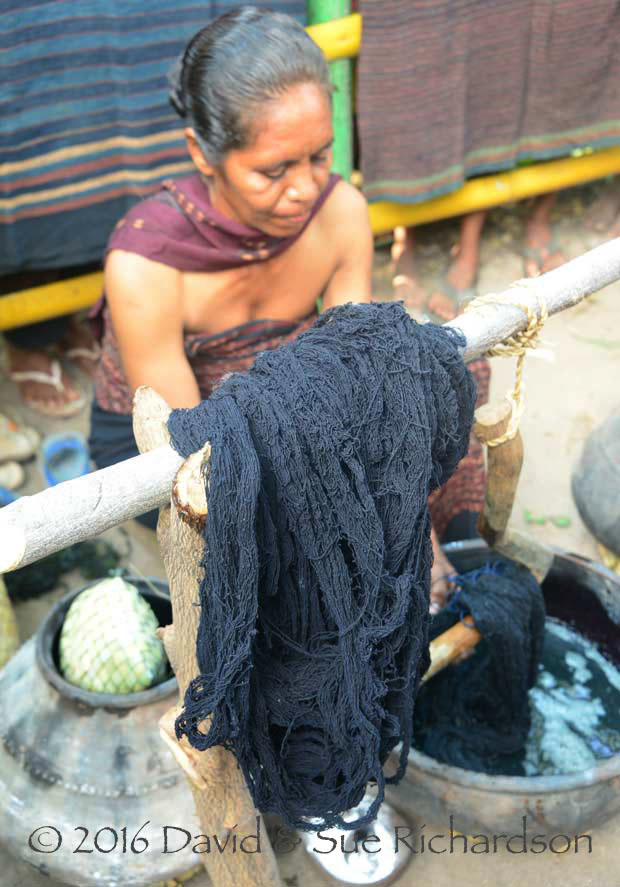
Very dark blue-grey hand-spun yarns that have been repeatedly dyed with indigo
Jontona, Kecamatan Ilé Api, Lembata Island
By combining a blue dye that absorbs in the red and a red dye that absorbs in the blue it is possible to produce an approximate black that absorbs across the whole visible light spectrum - although not uniformly. Many dyers achieved such blacks by darkening indigo with brown or reddish tannin pigments, sometimes with the addition of an iron mordant. In some cases the tannins were simply added to the indigo vat and in others they were used to overdye the indigo.
A similar technique was to combine indigo with morinda. In the Sikka region of Flores Island and on Lembata Island, a purplish-black tone is obtained by overdyeing indigo with morinda (see our webpage on indigo). On Savu Island, a near-black is still obtained by overdyeing morinda with indigo.
Burma
Some silk dyers produced a black by first dyeing their yarns a reddish-orange with the seeds of annatto (Bixa orellana), known locally as thidin, and then overdyeing them with indigo (Hardiman 1901, 36).
Sumatra
In the Minangkabau highlands near Padang, dyers obtained black by first boiling the yarns in a mixture of water and the barks of jiraq (Symplocos fasciculata) and rambutan (Nephelium lappaceum). This was followed by several immersions in aer kaleh, a mixture of indigo and ash water (Jasper and Pirngadie 1912, 68).
In the interior of Bengkulu, black was obtained from a solution of air timboe (boiled indigo leaves), sometimes mixed with lime, and morinda root and sometimes mixed with the bark of a wild tree called kayu sebasa (Jasper and Pirngadie 1912, 67).
Borneo
To obtain an intensely black colour, the Dayaks first dyed their yarns in morinda and then in indigo (Jasper and Pirngadie 1912, 70).
Howell found that some Iban achieved black by first dyeing their yarns red using with engkerbai leaves (Psychotria viridiflora) and lime, and then overdyeing them with indigo (Howell 1912, 61-64; Linggi 2001, 32).
Java
On the north coast of East Java the overdyeing of indigo with soga tingi was called nyoga, a term that may also have applied to the overdyeing of indigo with morinda (Heringa 1989, 113).
In Banyumas, Central Java, black was achieved by initially dyeing the yarns in indigo, then immersing three times in a soga dye bath made from mashed soga bark (Peltophorum ferrugineum), drying them in between, and finally immersing them three or four times in more indigo (Jasper and Pirngadie 1912, 63).

A kain batik irengan from Kerek, Java, used by a pendeta high priest for the Balinese ngaben ceremony. The deep black is achieved through a triple-stage dyeing process (indigo, soga, indigo) repeated seven times
At Plered, on the outskirts of Cirebon, they produced black and red yarns for export to Pekalongan. Black yarn was made in two ways. In the first, red yarn previously dyed with the bark of soga (Peltophorum ferrugineum) was overdyed in more soga mixed with black clay and an aniline dye called hëëdki. After drying and the removal of clay from the yarns they were steeped in indigo for five days. In the second, white yarns were first dyed a deep indigo blue and were then rubbed in a bath of soga and an aniline dye known as nopal (Jasper and Pirngadie 1912, 64).
Another method for obtaining black was to treat indigo-dyed cloth with the tannin-rich bark of tingi (Ceriops tagal) (Burkill 1966, 522-523).
Bali
In the village of Tenganan Pegringsingan, in eastern Bali, the local Bali Aga once invested enormous efforts to make ceremonial double ikat geringsing cloths with deep earthy tones of reddish-brown combined with brownish black. To obtain the black, the cotton yarns were first dyed with indigo. However because the Bali Aga considered indigo-dyeing to be an impure activity, they subcontracted this initial stage of the process to the neighbouring village of Bugbug (Bühler 1943, 243-247). After the yarns were returned to Tenganan they were pre-treated with candlenut oil for a period of 80 days (Bühler 1948, 2499-2500). This was followed by the crucial morinda-dyeing stage, the morinda root being pounded with the bark of kihip (Baccaurea racemosa) (Nabholz-Kartashoff 1991, 128; Hauser-Schäublin 1997, 99). The latter is a tropical fruiting tree generally known throughout Indonesia as kapundung, but on Java as kepundung or mundung (Cunningham, Maduarta, et al 2011). Its fruit is called menteng. In the past the yarns might be dyed repeatedly up to 25 times in the morinda/kihip mix, with intermediate drying times of three months. The Bali Aga believed that it was essential to expose the drying threads to both the sun and the overnight dew.
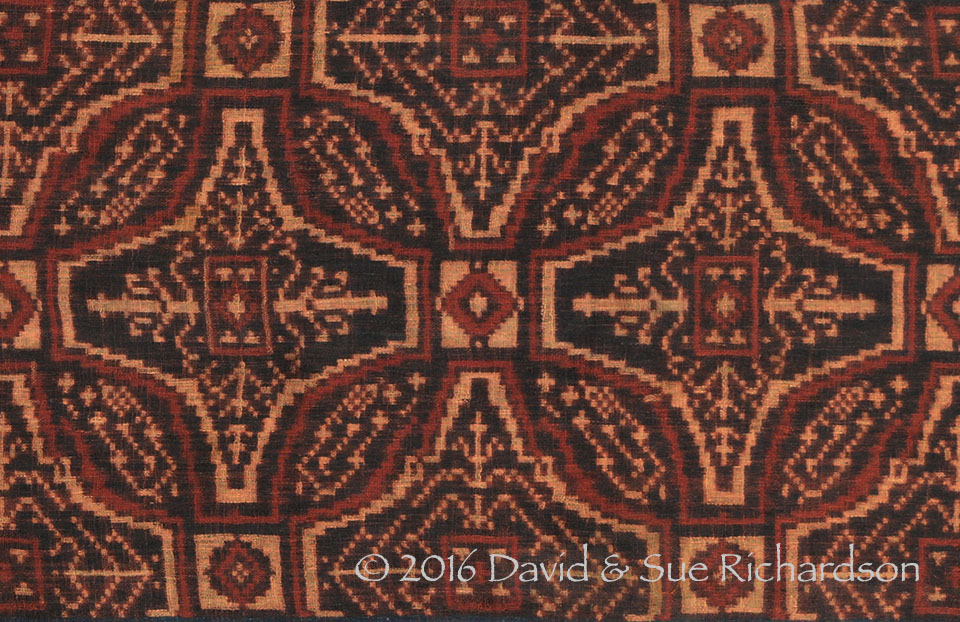
The black in this late nineteenth-century geringsing peparé from Tenganan, Bali, was achieved by dyeing the yarns deep indigo blue and then overdyeing them with morinda mixed with tannin-rich kihip bark
A similar process was followed on Nusa Penida Island, where Baccaurea racemosa is known as babakan pandung. In 1972 Max Weber recorded a recipe from a village close to Klumpu, in the island's centre. Powdered morinda (known locally as sunti), babakan pandung bark, candlenut oil and fish powder were added to water and filtered (Nabholz-Kartashoff 1991, 128). The yarn was then immersed in the bath and kneaded and turned. The process was repeated daily over ten days, a fresh bath being prepared every day.
Flores Island
Hamilton (1994, 67 and 270) gives some examples of where indigo-dyed yarns were sometimes overdyed to produce black by using the boiled extracts of various barks and dyewoods. Some used the barks of the mangrove species Rhizophera and Bruguier, termed bakau on Flores, while others used red sappanwood. Dyers in Mbay used the inner bark of the rengit tree, identified as Acacia glauca. Dyers in the Ende-Lio region used a tree called waé, possibly soga (Peltophorum pterocarpum) or Pterospermum diversifolium.
The Ata Sikka obtained a purple-brown, known as wungung, by immersing their yarns one or two times in indigo, followed by multiple immersions in morinda (Lewis 1994, 162).
The Lamaholot from East Flores, as well as some on Lembata Island, overdye their indigo with morinda to produce a purplish-black, known in Lamalera as fangē (Barnes 1994, 45). The overdyeing process is called belapit.
Palu'é Island
In the past, the Hata Lu'a people obtained a fine colour-fast near black for their characteristic red and black ikat sarongs and blankets by initially dyeing their yarns several times with indigo and then treating them in a tannin-rich dyebath (Danerek and Danerek 2017, 38).
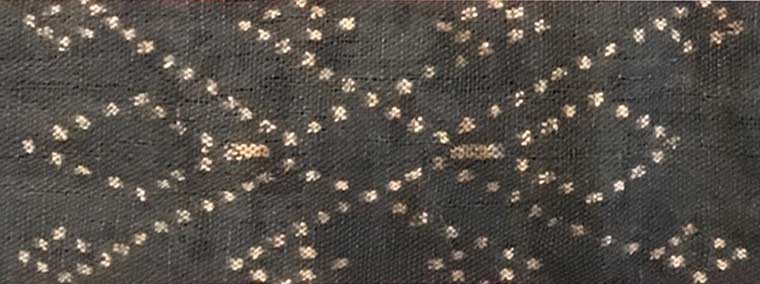
The Palu'é mbési or squash motif rendered on black
Sadly this traditional method is no longer used and details of the process have almost been lost. Fortunately the linguist Stefan Danerek has recently recorded the process, after interviewing Mama Longge Puine in her home in kampong Mata Meré in the domain of Kéli on the northern slope of the volcano. She described the procedure that was used by her late mother.
An indigo dye was prepared by soaking indigo leaves in water in an earthenware pot for three days. Then lime powder was added and once the indigo became yellow it was poured into a kora – a large split section of bamboo – so that the ikatted yarns could then be immersed and thoroughly squeezed. After three to four immersions and intermediate drying it was time to prepare the tannin solution.
Moro hae mangrove bark was added to water along with sun-dried langalidhi leaves and oily wuwu fruit seeds. The mixture was boiled until the water became red and was reduced to about half of the original volume. Then loi tubers collected from the forest were baked, cooled, skinned, mashed and added to the mix, acting as a starch to strengthen the yarn. The tannin/starch solution was poured into another kora so that the indigo-dyed yarns could be fully immersed and again well squeezed. The finished yarns were hung up and stretched with stones so they could dry.
The species of mangrove called moro hae has not yet been identified. Apparently it is a larger species of mangrove that grows along the north shore of Flores Island. It grows on the sea side of the mangrove forest and must therefore be harvested from the sea.
Lembata Island
The dyers on the north coast of the Ilé Api Peninsula create an excellent black by overdyeing a deep blue indigo with a cocktail of tannins. In addition to dyeing the cotton a deep black, the process strengthens the yarn, making it easier to weave.
They begin by repeatedly dyeing their drop-spun yarns with indigo thirty separate times. This is a laborious process, undertaken during the rainy season, each immersion taking two full days after which the yarns must be thoroughly dried before the next immersion.
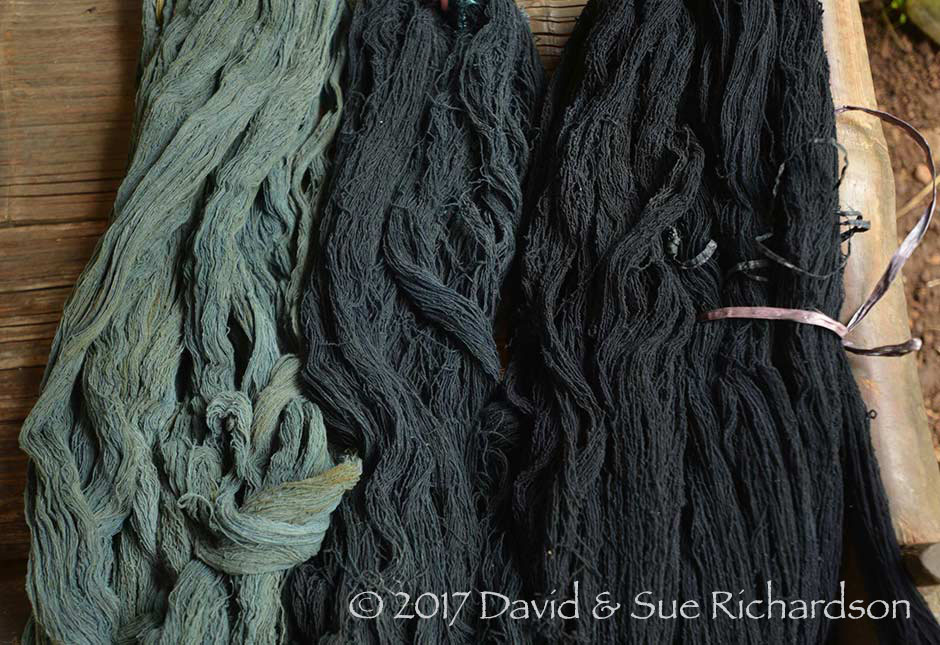
Hanks of hand-spun cotton repaetedly dyed with indigo 10, 20 and 29 times. Lamawara (Bungamuda), Kecamatan Ilé Api, Lembata Island
The production of the tannin bath is a hot process. The dyers boil ground tamarind seed, powdered mangrove bark and the outer shells of the Java Olive or Wild Almond tree (Sterculia foetida), known locally as kapok or wuka and elsewhere in the Lesser Sunda islands as nitas. The mangrove bark is powdered on a stone slab using a stone pestle. They also add a little lime powder. Once the mixture has cooled, a small amount is scooped into a plastic mug and the indigo-dyed yarns are laid on an old rice sack. The tannin mix is splashed onto the yarns and pushed into the fibres with the knuckles. Once a section has been treated, the yarns are turned and more mix is pumelled into them. After the application of four mugs of tannin solution, the yarns are thoroughly soaked through and are hung up to dry without rinsing.
The dyers emphasise that the yarns must not be immersed into the tannin mixture because this will make them stick together.
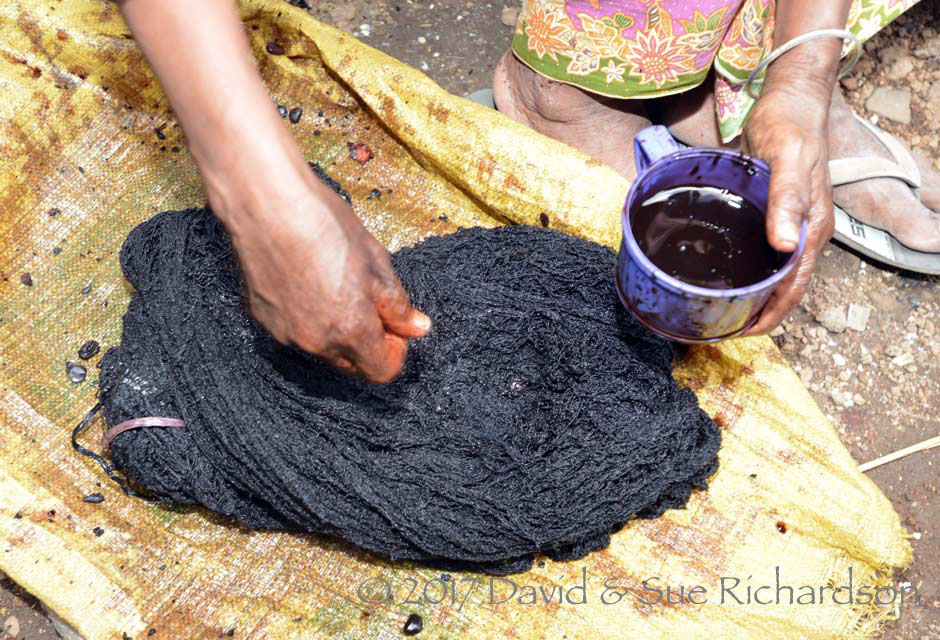
Mama Maria pummels the tannin mix into her indigo-dyed yarns.
Lamawara (Bungamuda), Kecamatan Ilé Api, Lembata Island
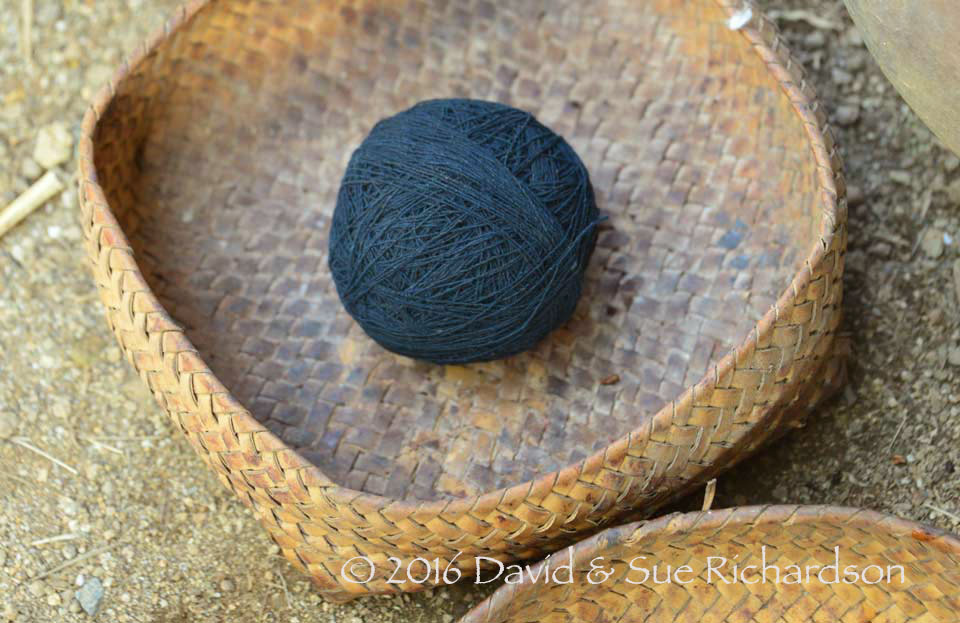
A ball of black hand-spun cotton at Napasabok (Mawa), Kecamatan Ilé Api, Lembata Island
Timor Island
On Timor Island, black was commonly achieved by overdyeing indigo with tannin-rich dyes extracted from tree barks and leaves. A vast number of recipes seem to have been used, varying from location to location. Normally the indigo-dyed cotton yarns were boiled with the chopped bark, leaves or whole herbaceous plants. These were selected from one or sometimes several species and seem to have produced a colourfast black (Cunningham, Kadati, Ximenes, Howe, Maduarta and Ingram 2014, 95).
One of the most available tannin sources is the seaside laurel, Phyllanthus reticulatus, a widely distributed tropical shrub or small tree. Other species identified by the above authors are:
| Family | Species | Common Name | ||
| English | Uab Meto | Tetum | ||
| Aster | Elephantopus scaber | Elephant’s foot | bia nekan, bia luken, bia sahaf | |
| Spurge | Homalanthus novoguineensis | Bleeding heart | matoi | |
| Homalanthus populneus | ||||
| Macaranga tanaruis | Parasol leaf tree, hairy mahogany | |||
| Phyllanthus reticulatus | Seaside laurel | meko | kalaen | |
| Legume | Acacia leucophloea | White bark acacia | besa | ai-besak |
| Albizia chinensis | Silk tree | |||
| Albizia julibrissin | Pink silk tree | |||
| Albizia lebbek | Siris tree | |||
| Peltocarpum pterocarpum | Yellow flame tree | pataij | ai-raek | |
| Sesbania grandiflora | Agati, corkwood tree | kane | ai-turi | |
| Mallow | Melochia umbellata | Melochia | ||
| Sterculia foetida | Wild almond tree, Java olive | nis metan | ai-nitas | |
| Myrtle | Psidium guajava | Common guava | koi, koijabas | |
| Syzygium jamun | Java plum | uhak | ||
| Mangrove | Ceriops tagal | Indian mangrove | klenuk | |
| Rhyzophora mucronata | Asiatic or red mangrove | katene | ||
| Madder | Gynochthodes sp. | |||
| Soapberry | Harrisonia brownii | Thorn bush | hau prata, makue | ai-tahantolu, si deki mea |
| Schleichera oleosa | Lac tree | usapi | ||
(Source: Cunningham, Kadati, Ximenes, Howe, Maduarta and Ingram 2014, 95-96)
In Biboki dyers produced black from a mixture of black earth, indigo, powdered lime, tree bark and sometimes burnt coconut meat (Mete 1990, cited in Yeager and Jacobson 2002, 65). Apparently black was worn by women because it symbolised eternity – unlike their husbands, they had to remain eternally within their homes!
Rote Island
Black was highly valued on Rote, where it was possibly used as a means of distinguishing its inhabitants from the neighbouring Timorese (Fox 1980, 43). It was produced using an alkaline mixture of indigo and tannin extracts. After immersing their pounded indigo leaves in water, dyers added slaked lime and the bark from one of the following: a Bruguira mangrove species, the yellow flame tree (Peltophorum pterocarpum), or the lac or kusum tree (Scleichera oleosa) (Bühler 1951, 3089).
Savu Island
On Savu some dyers obtain a dark bluish-black by initially immersing their yarns in morinda before the start of the indigo-dyeing process (Duggan 2013, private communication).

On Savu, yarns are dyed a near-black by overdyeing morinda with indigo
Return to Top
Mud Dyeing
An important way of producing a relatively fast range of dark colours, ranging from grey-brown to grey and black, was to treat a textile with tannin-rich plant material and then immerse it in mud from a stagnant pond, river or paddy field. It is important to note that although the technique is referred to as mud-dyeing, the mud is not the actual dye but simply a mordant - it is the tannin that is the dye. The initial tannin-dyeing stage is a hot process, but the subsequent mordanting in mud is cold.
Because this complex subject deserves a detailed review, please go to our dedicated page on Mud Dyeing.
Return to Top
Mangosteen
The mangosteen, Garcinia mangostana, is a tropical, slow-growing evergreen tree, closely related to Garcinia cambogia, the source of yellow gamboge. It is indigenous to the Malay Archipelago and was only introduced into India during the eighteenth century (Osman and Milan 2006, 12-14). It is now cultivated throughout Southeast Asia. The tree has an upright trunk and reaches a height of 7 to 25m. The rind of the edible fruit, technically known as the pericarp, is a deep reddish purple when ripe and a purplish brown when dried.
Mangosteen is known as men-gu in Burma, mangkhut in Thailand, mangkhud in Laos, mongkhut in Cambodia, manggis, masta and mesta in Malaysia and manggis in Indonesia (Quattrocchi 1803). The Thais also use the term mangkoot (Moeyes 1993, 169).
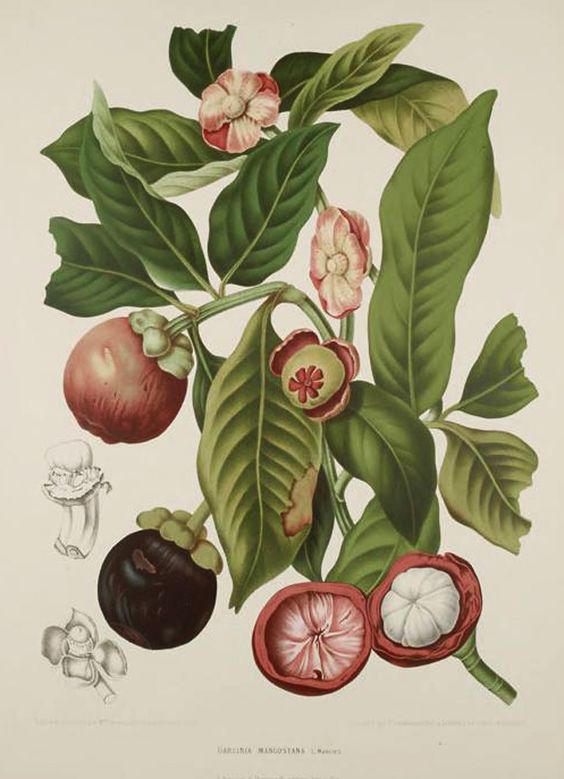
Garcinia mangostana (Berthe Hoola van Nooten 1880)

Ripe mangosteen fruits

Drying mangosteen pericarps (Image courtesy of Marvin V. Vicedo, Manila)
To date, more than 60 different polyphenols, known as xanthones, have been isolated from the mangosteen pericarp, bark, and roots. Xanthones are closely related to the anthraquinones. The mangosteen xanthones include various isomers of mangostin (such as α-mangostin, β-mangostin, γ-mangostin and nor-mangostin) as well as gartanin, 8-deoxygartanin, and 9-hydroxycalabaxanthone (Obolskiy, Pischel, Siriwatanametanon and Heinrich 2009). The pericarp also contains 7-14% catechin tannins and the flavonol rosin (Morton 1987, 304).
Mangostin is obtained by boiling the pericarps in water. It is a yellow crystalline solid that is insoluble in water.
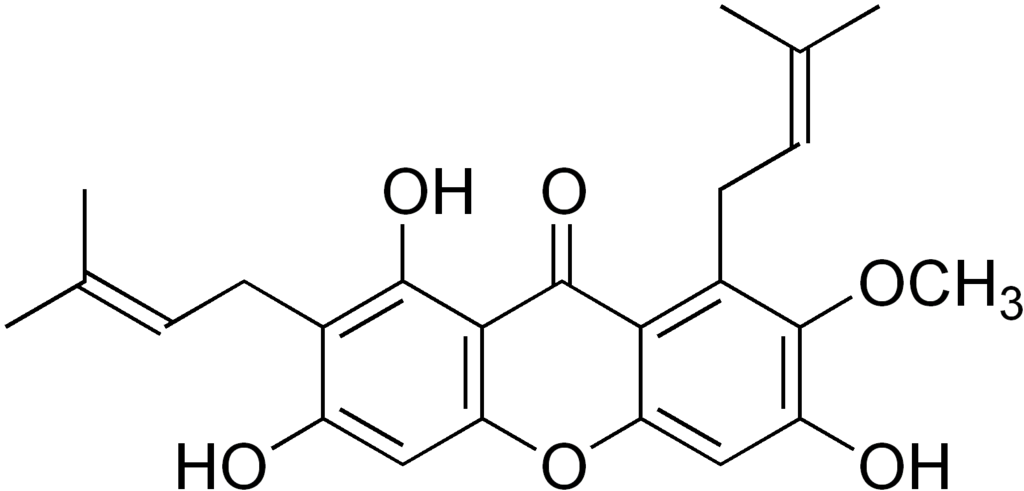
The chemical structure of mangostin
Other researchers have found that the pericarps of mangosteen also contain two red anthocyanin pigments, cyanidin-3-sophoroside and cyanidin-3-glucoside, the former more dominant than the latter (Kanchanapom and Kanchanapom 1998; Chairat, Bremner and Chantrapromma 2007). While these probably contribute to the colour of the ripe fruit, such anthocyanin pigments are relatively unstable and are easily oxidised (Saptarini, Fathi and Sofian 2013). It is therefore unlikely that they play any part in the dye properties of the dried pericarps.
An Indian laboratory test of the dye extracted by boiling dried mangosteen pericarps found that it absorbed light in the green and especially the blue part of the visible spectrum, therefore appearing red (Vankar et al 2009).
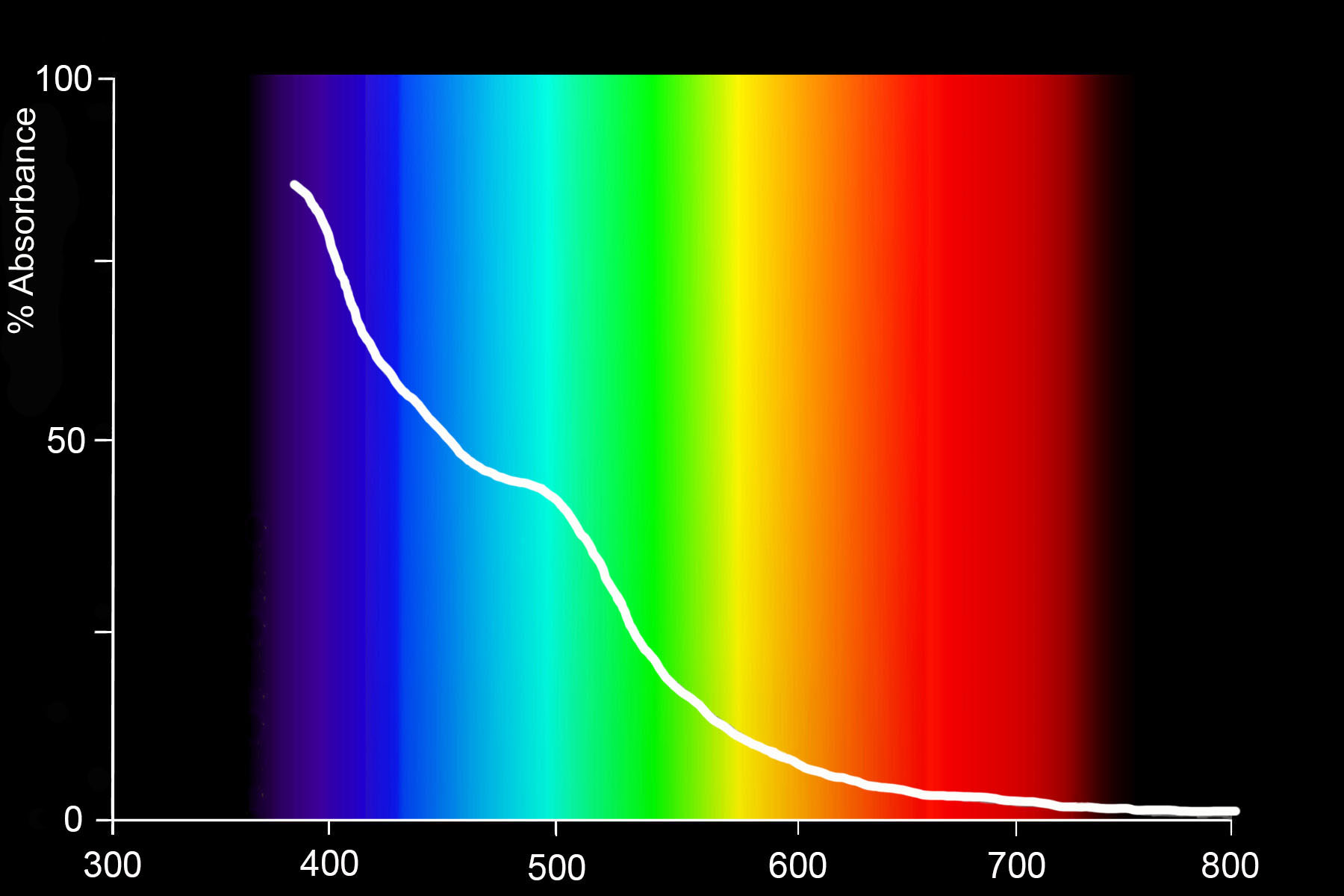
Absorbance spectrum of aqueous extract of Garcinia mangostana
The dye was tested on cotton pre-mordanted with tannin as well as silk and wool using a range of metal mordants. It produced a range of colours from camel brown to dark chocolate brown, as well as khaki green with good light and wash-fastness properties. Iron, chrome and copper were found to be the best pre-mordants.
Pre-mordant |
Cotton |
Silk |
Wool |
Alum |
Khaki brown |
Camel brown |
Light brown |
Ferrous sulphate |
Greenish brown |
Greenish brown |
Greenish brown |
Stannous chloride |
Camel brown |
Camel brown |
Light brown |
Copper sulphate |
Brown |
Light brown |
Khaki green |
Potassium dichromate |
Brown |
Almond brown |
Camel brown |
Stannic chloride |
Almond brown |
Light brown |
Light brown |
Results of Vankar et al 2009
These results appear to conflict with numerous historical reports that both the rind of the fruit and the bark of mangosteen have been used to prepare a black dye. For example:
- the Chinese use the rind to dye black (Stockdale 1811, 45)
- in Malaya the shell is used to obtain a black dye (Burkill )
- the rind of its fruit is used for dyeing black (Balfour 1885, 1005)
Details of the process for producing black, apart from the fact that the pericarps are soaked in water and require an iron mordant (Schmid 1855, 331), seem to have been lost. In his dictionary of the ‘Indian islands’ John Crawfurd recorded that black was commonly produced by mixing the rinds of mangosteen and katapang (Terminalia cattapa) with sulphate of iron (Crawfurd 1856, 135).
This might suggest that the black colouration arises not from the reddish mangostin, but from the combination of the tannins in the mangosteen pericarp and tree bark and the iron mordant – see the chemistry of iron tannin dyeing above.
It seems that although mangosteen was cultivated for its fruit in Burma, it was not particularly valued as a dyestuff (Balfour 1885, vol. 3, 519). John Nisbet found that enormous quantities of their husks were thrown away at the ports of Moulmein, Tavoy and Mergui - with little comprehension of their economic worth (Nisbet 1901, vol. 1, 352).
In Cambodia, Kikuo Morimoto’s Institute of Khmer Traditional Textiles (IKTT) near Siem Reap produce their black dyes from both the fresh and dry leaves of local Indian almond trees.

Detail of a silk samphot hol with a black ground, woven at IKTT
In Northeast Thailand, Kikuo Morimoto earlier recorded that mangosteen pericarps were used to produce just brown and grey colours (Gittinger and Lefferts 1992, 246). Today in southern Thailand villages in Nakhon Si Thammarat, such as Ban Kiriwong, use mangosteen hulls to make a reddish-brown dye for both silk and cotton but they do not use a metal mordant (Chairat, Bremner and Chantrapromma 2007).
On Sumatra, William Marsden found that the local black dye was commonly made from ‘the coats of the mangosteen fruit and of the ‘kataping’ (Terminalia catappa)’, the latter commonly known as the Indian or sea almond (Marsden 1811, 95). Marsden noted that the Minangkabau used this same dye to blacken a blue cloth imported from the west of India, fixing the colour by steeping the cloth in mud. His remarks are confusing. Was the use of mud to mordant the dye a key part of the Sumatran process, or was mud used only by the Minangkabau?
During the 1840s, the botanist and colonial administrator Sir Hugh Low found that in British Borneo (Sarawak) the rind of mangosteen was used to tan leather and to produce a black dye (Low 2002, 121).
On Java, Sir Stamford Raffles noted that a black dye was made from the bark of several ‘exotic’ trees combined with the rind of mangosteen (Raffles 1830, vol. 1, 44). However when making batik, the black dye was made from the rind of mangosteen fruit mixed with the bark of tingi (Ceriops tagal) in a bath treated with lye made from the ash of rice chaff (Raffles 1830, vol. 1, 189).
Return to Top
Siamese Ebony
In Southeast Asia, but not Indonesia, grey and black colours were obtained from the fruit or seedpods of the ebony species Diospyros mollis, a shrub or middle-sized tree that grows in mixed deciduous forests throughout the region (Quotrocchi 2012, 1433). It is related to the persimmon.
Known locally as the Siamese ebony, Diospyros mollis is still widely planted in Burma, Laos, Cambodia and Vietnam (Bechtold and Mussak 2009, 68). The fruiting season is very short, but because the fruits are so rich in tannin they can be preserved for a whole year simply by immersing them in water.

Fresh and older oxidised berries of ebony
Diospyros mollis contains an important phenolic constituent called diospyrol, a polyhydroxyl bi-naphthyl. Diospyrol is highly sensitive to oxidation and rapidly blackens into a relatively fast pigment when exposed to air (Loder, Mongkolsuk, Robertson and Whalley 1957, 2233; Mongkolsuk and Sdarwonvivat 1965, 1533). It has been suggested that this oxidisation leads to polymeric coupling (NIIR Board of Consultants and Engineers 2005, 46).

Diospyrol, a polyphenol composed of four phenol groups
The leaves and fruits of the Malabar ebony or Indian persimmon, D. malabarica, which grows in India, Southeast Asia and Indonesia, have been used in a similar way (Heyne 1950; Green 1995, 57). In Vietnam, some dyers have used the fruits of the Mun ebony, D. mun, instead (Vũn 1996).
In Burma, mon (Diospyros mollis) was said to be common in the mountains of the southern state of Tavoy (Mason 1852, 181). The fruit was used in Pyinmana and Tharrawaddy to produce a dull black, the dyeing process being repeated three times daily for six days (Fraser in Scott and Hardiman 1900, 383). Ebony fruit was more widely used in Shan State to dye both silk and cotton (Hiern 1874, 239; Hallett 1890, 87). Known as Shan black, the dye was normally prepared from the pulp of the raw berry but sometimes the Shan added a small portion of iron filings to enhance the hue or at other times lime. Cloth dyed with ebony fruit was claimed to withstand constant wear for several years without losing its colour.
In Thailand, Siamese ebony is called ma klua, as well as mak klua and phee phao (McFarland 1944, 631; Moeyes 1993, 147; Quotrocchi 12012, 1433). Silk was dipped into the cold ma klua dye bath and then placed in direct sunlight. The colour gradually appeared as the dyeing agent oxidised – Moeyes compares the process to dyeing indigo. Depending on the number of immersions, ma klua can produce tones ranging from light grey to black, up to 40 dips being needed to achieve a deep black. The dye is fast and does not damage the fabric.
The Siamese seem to have used ma klua extensively as a black dye in the past with the fruit berries being traded widely for this purpose (The Record, Siam Dept. of Commerce 1926, 572). One early report emphasised that the dye had to be prepared from fresh green berries, which were first bruised then allowed to ferment in water (Balfour 1873, 59). The cloth was steeped in the dye and then spread out in the sun to dry. It was still being used by a few dye workshops around 1940 (Thompson 1941, 444). W. Credner reported that a large amount of black silk was produced in Bangkok for export by dyeing it with fresh unripe ebony berries (Bühler 1948, 2495). The dyeing was repeated twenty times, the fabric being dried between each immersion.
The berries themselves were not exported from Thailand because they had to be collected before they were ripe and used while still fresh. Details of the black dye were presented to the ninth Pacific Science Congress in Bangkok in 1963. Ma klua was very fast to both washing and light, and was effective on both cotton and silk. In the latter case it also had the property of ‘weighting’ the silk – reversing the loss in weight caused by degumming the silk fibres. The dyeing process was incredibly simple. The fresh fruit was ground and mixed with water to produce a pale yellow turbid liquid. The fabric was then soaked in the dyebath and dried in the sun. This process was repeated many times until the required dye strength had been achieved and a satisfactory increase in the weight of the silk had been obtained (Tab and Rabieb 1963, 52).
According to Anasee Stone, ebony berries were the traditional ingredient for making black in the Isaan region. Local women cultivated ebony in their gardens, or harvested the berries from trees around their village. First the ripe berries were crushed to a pulp and mixed with lye, then water was added in measured amounts and stirred until a smooth liquid was produced (Stone 2009, 43).
Susan Conway confirmed that ebony was a traditional way of dyeing black, especially in northeast Thailand and that women often cultivated the shrub in their gardens for dyeing both cotton and silk (Conway 1992, 75-76). In the process that she observed, the ebony fruit berries were crushed into a pulp and mixed with lye (alkali). Water was added and the mix stirred, after which the cotton skeins were immersed for three days, being frequently turned to ensure an even colour. In northeast Thailand, cotton was pre-mordanted with a lye prepared by mixing wood ash with ash made by burning the shells of a large river snail. The cotton yarns were laid out in the garden and coated with the mixed ash before being taken to the riverbank to be kneaded in the clay sediment, after which they were rinsed and dried. This may have been a way of impregnating the yarns with a mineral mordant such as ferrous iron.
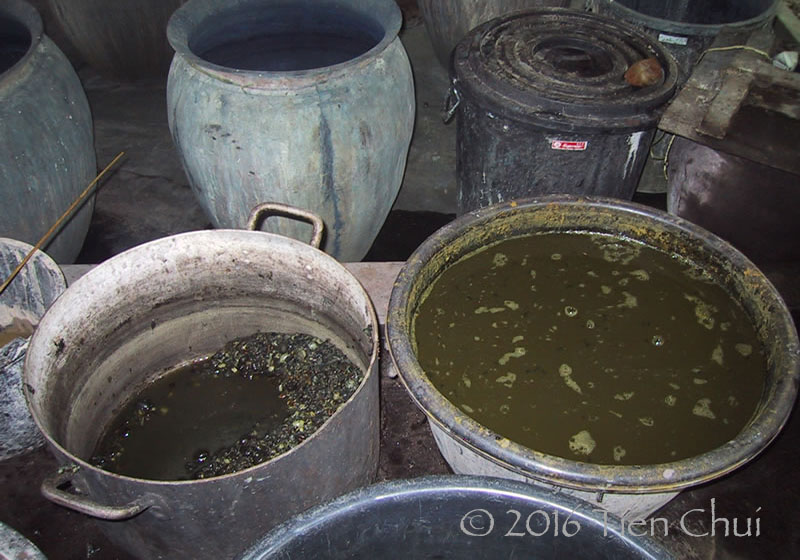
Ebony fruits soaking in water in Carol Cassidy’s workshop, Vientiane, Lao PDR
(Image courtesy of Tien Chui, San Francisco, California)
An analysis of black cotton from eleven Tai textiles collected in the 1920s and 1930s showed that around half had been dyed with ebony berries (Swetzoff 1992, 250). In one or two cases the ebony had been combined with indigo.
In Laos, where the fruits are called mak gleua, they were used to obtain shades of grey and black (Cheesman 1988, 55 and 59). After soaking the fruits were pounded and mixed with lye, the yarns being dipped for just 30 minutes before drying. Four repeat dyeings were required to obtain a deep black. The same mix was also used as a mordant for cotton, yarns being given a single preliminary dip to ensure the fastness of subsequent dyes. Dyers used an alkaline mixture of mak gleua seedpods and the root wood and bark of sappan or mai fang to produce a dirty red (Caeselpina sappan).
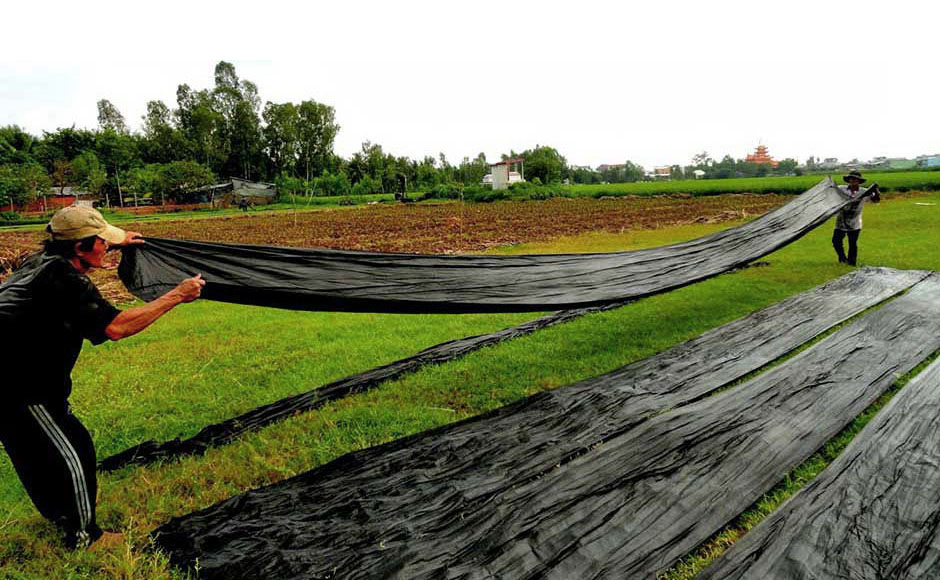
Drying ebony-dyed silk at Tan Chau, South Vietnam
(Image courtesy of Ngoc Suong Dang, Ho Chi Minh City, Vietnam)
Surprisingly Diospyros mollis fruit berries are still being used by one traditional dyer to produce deep black silk in the Mekong silk weaving village of Tan Chau in South Vietnam. To achieve an intense black the silk is immersed in the mặc nưa dye bath and dried in the sun daily about 100 times over a period of 40 to 45 days (Froger 2014).
In the Philippines, the main black dye in south central Mindanao is said to be derived from the leaves of a small tree called either kinarum or k'nalum - thought to be a species of Diospyros (Hamilton 1998, 26 and 172). An earlier source indicated that the dye could also be extracted from the root and bark (Cole 1913, 79, cited by Hamilton 1998, 172). Likewise in southern Mindanao, many of the local tribes produce their black from the young leaves and root bark of various Diospyros species, known variuosly as kanallom, kinarem, nalum, kinalum and kanalom (Quizon 1998, 111). The leaves and root bark are pounded into a pulp and boiled in water. The yarns are initially steeped in the boiling dye bath and are then placed into a container which is somehow inverted over the steaming solution. Exposure to the steam from the boiling dye bath apparently deepens and sets the black pigment. It takes from three days to one week of repeated steeping and steaming to achieve the desired tone. Some dyers add synthetic dye to speed up the process. What is surprising about these recipes is that no mention was made of the use of the ebony fruits.
It seems that Diospyros mollis is not found in Indonesia (Subansenee and Phengklai 1991). However roughly 100 other species of Diospyros grow in the archipelago, especially the native Indonesian ebony , D. celebica, also called Macassar or Sulawesi ebony (Cunningham and Campbell 2005, 214). However intensive logging has greatly depleted Indonesia's ebony reserves and even on Sulawesi, where Indonesian ebony was once prolific, it has been virtually eradicated from the south of the island (World Conservation Monitoring Centre 1991). We can find no reports that the fruit of this or other ebony species have been used as a dye in the Indonesian archipelago.
Return to Top
Myrobalan
The tannin-rich fruits, leaves and bark of the myrobalans have been widely used as both a mordant and a yellow, brown and black dye for both cotton and silk. However they can only produce black with the aid of an iron mordant (Jansen and Cardon 2005, 164).
The term myrobalan is applied to trees belonging to the genus Terminalia, a family of about 200 tall tropical deciduous trees producing small globular fleshy fruits, ranging in size from hazelnut to walnut and in colour from yellow to black. The most well-known are the Indian myrobalan (T. arjuana), black or chebulic myrobalan (T. chebula), bastard or belleric myrobalan or beach almond (T. bellerica), yellow or citrine myrobalan (T. citrina) and the Indian almond (T. catappa), sometimes called the Java or sea almond.
The dried fruit pulp of black myrobalan has an average tannin content of 30%, although this varies depending on origin (Jansen and Cardon 2005, 162).
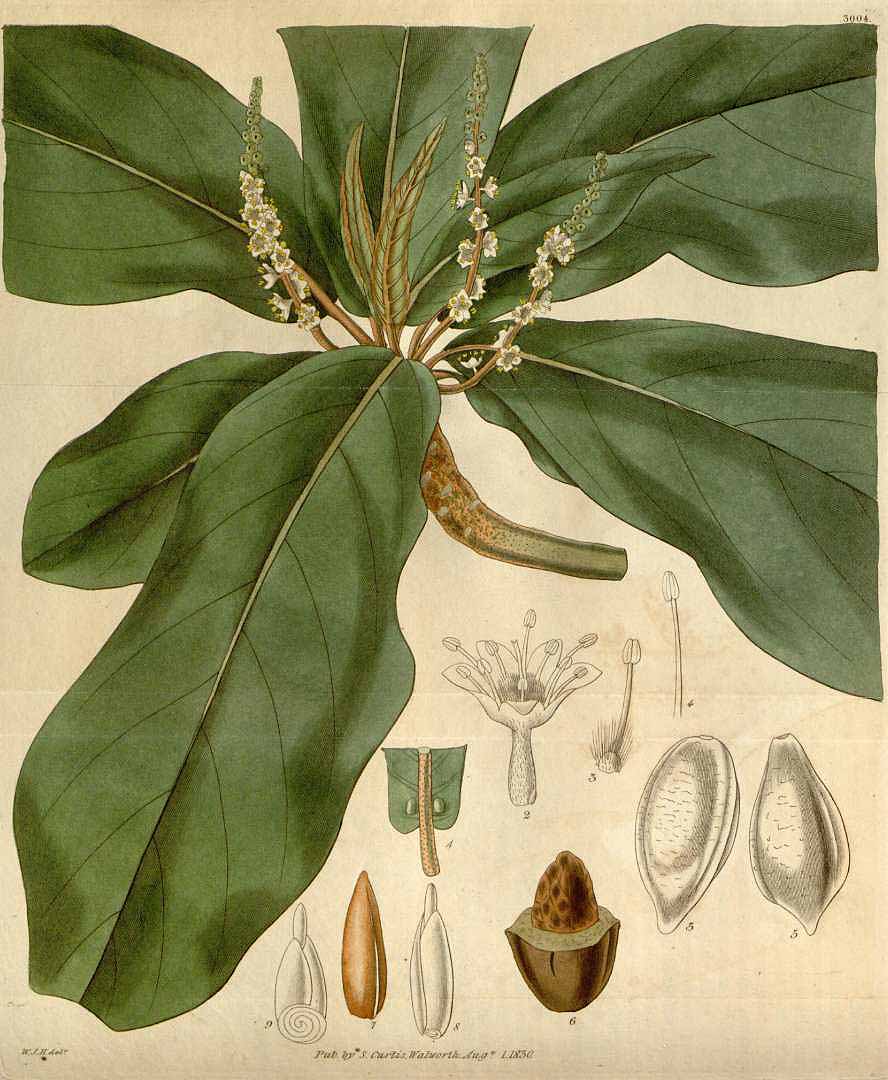
The Indian almond, Terminalia catappa
(W. J. Hooker, Curtis’s Botanical Magazine, vol. 57 [ser.2, vol. 4], plate 3004, 1830)
In Southeast Asia the bark and leaves of Indian almond were used to make black (Green 1995, 57).
In Burma, the fruits and barks of several species of Terminalia were once used to produce a black dye (Fraser in Scott and Hardiman 1900, 383-385):
- taukkyan - the Indian laurel (Terminalia elliptica, synonym of Terminalia alata)
- panga - the Indian laurel (Terminalia elliptica, synonym of T. tormentosa)
- thitsein - bastard or belleric myrobalan (Terminalia bellerica)
- lein - white chuglam (Terminalia bialata)
- kyazu - black or chebulic myrobalan (Terminalia chebula)
In Tharrawaddy they used the pounded fruits of panga and thitsein. After three immersions the cloth was mordanted with iron filings or swamp mud. An alternative was to use the bark and leaves of taukkyan prior to the mud immersion. In Prome they heated panga fruit with jaggery, iron and vinegar. In Magwe they made an infusion of madama bark (Ceripos tagal) and subsequently added panga fruit, zibyuthi (Phyllanthus longifolius) and rusty iron. In Tavoy and Lower Burma they boiled the fruit of kyazu with iron filings, while in Rangoon they mixed kyazu fruit with jaggery and heated iron, leaving the dye bath for 15 days to mature. The bark of lein was used for dyeing fishing nets.
Black myrobalan was also used to obtain black in Pegu (Abreu 1858, 188).
Despite its widespread use as a black dyestuff in India and Burma it is surprising to find that there are only a few references to its similar use in Malaysia, Indonesia and the Philippines. One survey reported that the bark of 'katapping' (T. catappa) was used for dyeing black on Sumatra (Cooke 1861, 136). Another reported that the fruit of the very same 'katapang' was combined with sulphate of iron to produce black on Java (Balfour 1871, 183). A third mentioned that the trunk and fruit of the same tree was used as a source of yellow and black dyes on Bali (Heim 2015, 100).
John Foreman stated that in the Philippines, the sap of the talisay tree, T. mauritiania, was used as a black dye (Foreman 1892, unnumbered). Sylvia Fraser-Lu claimed that it produced brown (Fraser-Lu 1988, 31). Another reference indicates that T. catappa was used as a source of brown or black on Mindanao (Casini 1981, 132).
Return to Top
Rambutan
The rambutan (Nephelium lappaceum) is a tropical evergreen tree with an open, spreading crown. It usually grows about 9 to 15 metres tall but sometimes reaches 25 metres. It thrives in humid tropical lowlands up to 600m. It seems to have originated in the Malay Peninsula before spreading westwards towards Thailand, Burma and India and eastwards into Indonesia and New Guinea. Today it is widely cultivated throughout the region (Tindall 1994, 5).
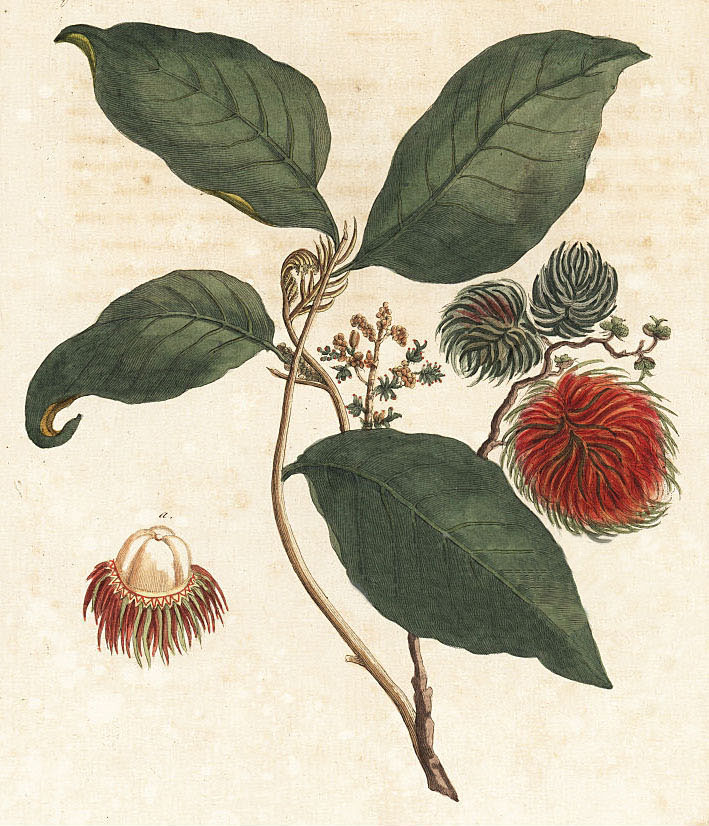
Nephelium lappaceum (Friedrich Johann Bertuch 1807)
In Thailand rambutan is called ngo and phruan, in Cambodia ser mon and chle sao mao and in Malaysia rambut. The Iban called it buah sibau or just sibau.
The pericarps of rambutan contain tannins and saponin (Shaw, Chan and Nagy 1998, 328). They are therefore sometimes used by artisan dyers to produce shades of tan and grey.
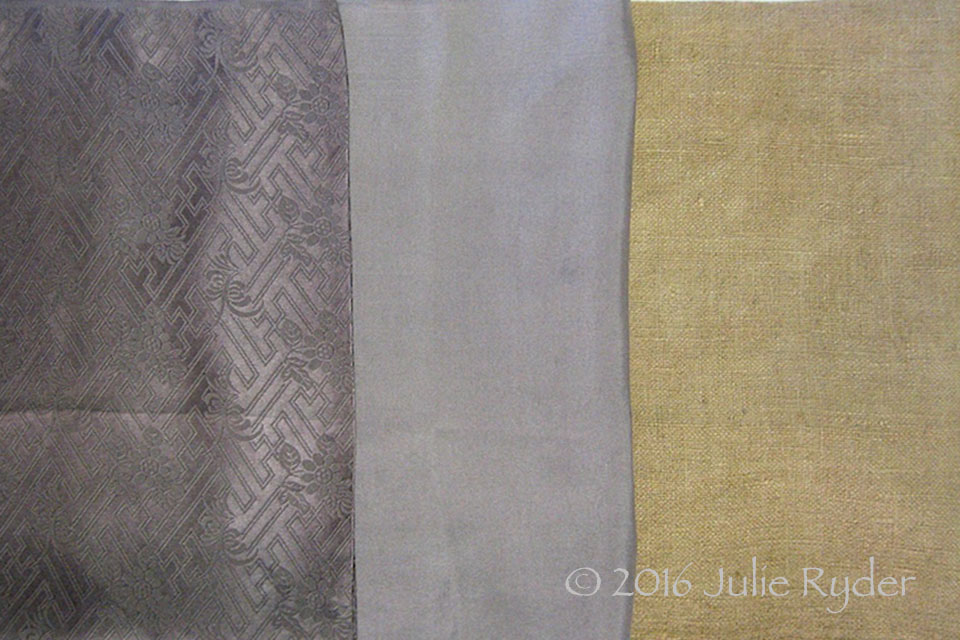
Three samples of silk dyed with rambutan pericarps using a mordant of iron (left and centre) and alum (right) (Image courtesy of Julie Ryder, Canberra)
However some reports suggest that rambutan pericarps were used to produce black, although the recipes are never specified. For example, in southern Thailand they were once used by the dyers at Baan Na Mun Sri to make a black dye (Fraser-Lu 1988, 31). In other places the pericarps were mixed with other tannin-rich plants to dye silk black after it had first been dyed red (Westphal and Jansen 1989, 196). This process was used by dyers at the important weaving centre of Pekan in Malaysia (Howard 1991, 51).
In Lampung, Sumatra, a black dye was extracted from the bark of the rambutan tree (Totton 2009, 42).
Other reports suggest that in some locations the leaves of rambutan were used in combination with mud to produce a black dye that did not appear to have been particularly fast (Westphal and Jansen 1989, 196; Sharma 2009, 202). In Singapore the leaves were boiled in water together with mud from the riverbank to dye yarns for making black cloth (The Gardens’ Bulletin Singapore 1906, 235). On Borneo the leaves were mixed with mud (Burkill 1935, vol. 1, 276). The Iban used the leaves with other species to dye baskets (Blehaut 1994, 48).
Return to Top
Straits Rhododendron
The Straits rhododendron, also known as the Indian or Singapore rhododendron and the black strawberry tree, Melastoma malabathricum, is an extremely variable species. It is a short erect perennial shrub that rarely exceeds one metre in height and has cream, pink or purple flowers and rough, black, berry-like fruits containing minute seeds. It is a prolific weed and can form dense thickets on wasteland and open fields. It is distributed from India through the whole of Southeast Asia and Indonesia to Australia, Melanesia and Polynesia (Holm 1997, 469-471).

Melastoma malabathricum (Elizabeth Twining 1868, plate 56)
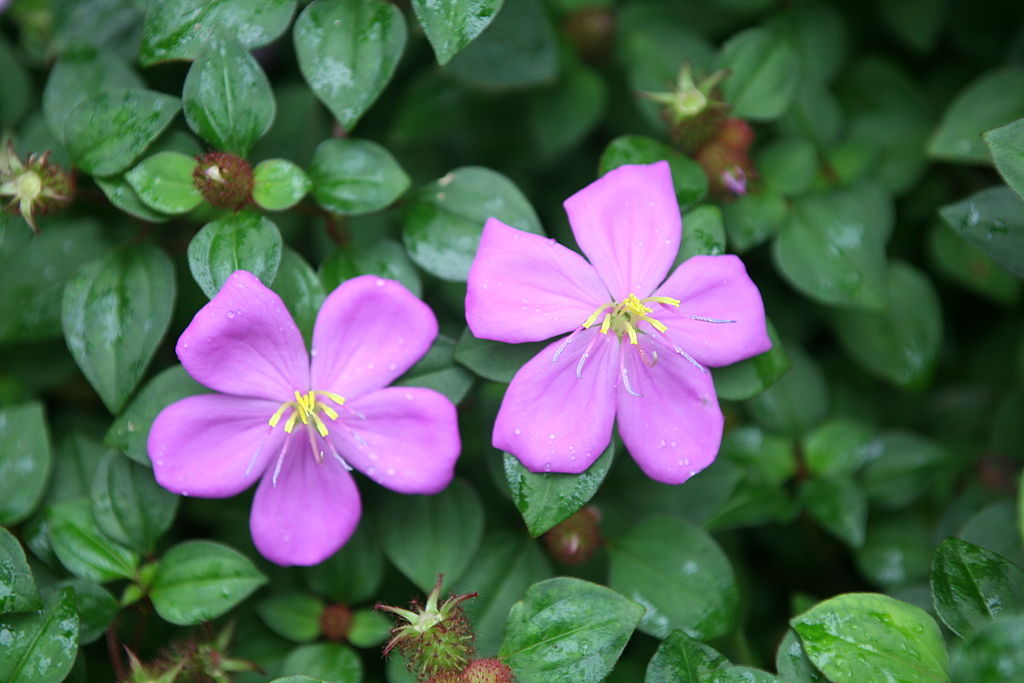
A small-leaved variety of Straits rhododendron, Melastoma malabathricum
In India the Straits rhododendron is known as phutuka, in Thailand as mang krea, and in Malaysia and Indonesia senduduk. The Iban of Sarawak refer to it as kemunting while on Java it is variously termed harendong, kemanden and senggani.
The term Melastoma is derived from the Greek for ‘black mouth’, derived from the effect on the mouth of those who eat the fruits (Edwards, Bellenden and Lindley 1822, 672-673). The berries of various species of Melastoma are reported to dye a very long-lasting black (Grey 1821, 104). The juice is so black that in some places it was used as an ink.

The mangosteen-like fruit of Melastoma malabathricum
(Image courtesy of Teo Siyang, Singapore)
It seems that the fruits of Melastoma malabathricum can be used to make black, the leaves can be boiled with other ingredients to make pink and purple, while the chopped roots can be used in mixtures to produce red (Lemmens and Soetjipto 1991, 16; Howard 1991, 49). Other sources indicate that the ashes of senduduk can be used as a mordant.
Edward Balfour described it as one of the black dye plants of Asia, noting that its edible fruits were used to dye cotton purple (Balfour 1873, 225).
In Burma, Francis Mason recorded that dyers used the fruit of 'the melastoma' to make a black dye (Mason 1850, 181).
According to Michael Howard, the fruits were used to make a black dye by the dyers of Selangor, West Malaysia, and by the Iban of Borneo (Howard 1991, 49). Given the widespread availability of this plant it is surprising that there are no other reports of its use.
The fruits have recently been used to dye polyester using a fixer of either sodium hydroxide or chitosan (Ahmad, Abidin, Ahmad, Ab Kadir and Yusof 2014, 85-88). Polyester is hydrophobic and normally difficult to dye.
There are several reports that the leaves were used instead. In India they were used to dye cotton black (Twining 1868, unnumbered), while in China they were said to produce a 'serviceable' black dye (Murray 1836, 360). In the Pegu region of Burma, however, they were said to make a fine black dye (Abreu 1858, 188).
Return to Top
Krajai
In north-east Thailand, the berries of the krajai tree, louk krajai, are pulverized and soaked in water for thirty minutes (Fraser-Lu 1989, 31). The dye was used to colour the silk yarns used to weave silk weft ikat mudmee (Conway 1986. 16). The dye is still used to produce black by the same Tai Lao weavers in the villages of Isaan (Stone 2009, 166). It is also used at the important silk brocade weaving centre of Tasawan in Surin Province.
Unfortunately we cannot identify the tree species involved (the Thai word krajai means ‘star’).
In the Isaan region of Thailand the dyeing of kraijai is apparently surrounded by superstition, just like indigo dyeing in Indonesia. Dyers believe that the presence of Buddhist monks or pregnant women will cause the colour to fade. Consequently weavers prepare this dye in a secluded location outside of the village (Peetathawatchai 1973, 48).
Return to Top
Indonesian Bay
The Indonesian bay (Syzygium polyanthum, formerly known as Eugenia polyantha) is a tall deciduous tree that grows up to 30m tall. It is widely distributed in Burma, Indo-China, Thailand, Malaysia, and Indonesia, including Java, Sumatra and Kalimantan. Locally it is known as salam in Indonesia, but also ubar serai on Sumatra and manting on Java (Sardjono 1999, 218-219). In Malaysia it is called samak, kelat samak and serah; in Cambodia pring srâtoab; in Thailand daengkluai (central), dokmaeo (peninsular) and mak (Chumphon, Ranong).

Syzygium polyanthum
(Korders and Valeton 1915, Atlas de Baumarten von Java, vol. 3, plate 470)
The genus Syzygium contains over 1,000 species of evergreen trees that are found throughout the Indian subcontinent and Southeast Asia (Janick and Pauli 2008, 551). It contains a number of species that were formerly classified as Eugenia (Pauli and Duarte 2012, 92). Many are cultivated for their edible single-seeded fruit, such as the water apple (S. aquem), Java plum (S. cumini), and wax apple (S. samarangense).
The leaves of Syzygium polyanthum contain tannins and flavonoids.
There are numerous reports of black dyes being extracted from a large number of Syzygium species. Details of the process involved are never given, although some mention the addition of (acidic) lime juice (Jansen and Cardon 2005, 147).
The bark of the Indonesian bay pounded with water yields a brownish-red dye, which was used widely in the Dutch East Indies for tanning fishing nets and for dyeing bamboo matting brown-red (McFarland 1944, 336; Weiss 2002, 122). For further blackening the matting was subsequently immersed in mud.
Salam tree bark was used to produce black in Lampung, Sumatra (Totton 2009, 42). The leaves produced a dark brown.
A recent survey of lowland resources in Riau Sumatra and West Kalimantan identified three species of Syzygium capable of producing a black dye: Syzygium acuminatissima, S. jamboloides and S. spicatum (Paludiculture: sustainable alternatives on degraded peat land in Indonesia, 31.01.2013). The bark of S. polyanthum has been recently used by batik makers on Java to produce a purplish dye.
Return to Top
Other Black Dyes
It is likely that a huge variety of other plant species were used in the past to make black. Of those that have been recorded, the details of the associated dyeing process have generally not survived.
The resourceful dyers of Burma produced black pigments from various sources other than those described above. They used the barks of madama (Ceriops tagal), palan (Bauhinia diphylla), tamazok (Agyneia coccinea), lamu (Sonnaratia acida) and the leaves of saukpin (Elaeodendron integrifolia) (Fraser in Scott and Hardiman 1901, pt. 1, vol. 2, 383-384). In the Pegu region a black dye was obtained from the fruits of Semecarpus anacardium (Abreu 1858, 188).
In Cambodia, silk dyers still use various tree barks mordanted with iron (Sokny, Ratha and Vannak 2007, 30). In one recipe, barks from the ampil toek (tamarind water tree) and chatra trees are boiled for two hours and cooled. After immersing the silk, the temperature of the dye bath is raised to boiling. The dyed silk is finally washed in smin water and dried. Smin water is prepared by adding one kilogram of rusty iron, one kilogram of sugar palm, and thirty sliced lemons to 30 litres of water in a jar and leaving it in the sunlight for 5 to 7 days. An alternative method is to boil chipped dyewood from the lychee tree (Litchi chinensis) with iron for two hours.
In Vietnam, the leaves of Dalbergia mammosa have been used to make a black dye (Vũn 1996). The leaves of the white siris tree, Ailanthus integrifolia, have also been used to dye silk black (Lemmens, Lemmens, Soeriangnegara and Wong 1995, 59).
On Sumatra, Marsden was impressed by a black dye made by boiling parts of an unidentified shrub called kattam by the Musa, who lived near the source of the Musa River, and timboo akkar by the Malays (Marsden 1784, 79). The shrub might possibly be patchouli (Pogostemon cablin). At Palembang, black was obtained from a decoction of the roots of the wild pipit plant (Jasper and Pirngadie 1912, 67 note 3). It is not clear if this is the same as terong pipit, the wild pea aubergine (Solanum torvum).
On Borneo a wide range of species were exploited to produce black dyes. The Iban prepared a black for dyeing baskets from the leaves of the evergreen sawih tree (Duabanga moluccana) (Blehaut 1994, 224). The chopped barks of Duabanga moluccana and Mallotus moluccana were sometimes used as a black dye to stain baskets made from pandanus leaf (Uphof 1959). In the Philippines, where the tree is called loktob, the bark was boiled in water to make a black dye (Ramon Aboitiz Foundation).
The Iban are also known to have used the large, juicy leaves of the Plethiandra beccariana, formerly Medinillopsis beccariana, to obtain black (Haddon and Start 1936, 20; Fraser-Lu 19, 41). John Wilson reported that in Sarawak ikatted cotton was dyed black using an unspecified variety of local leaves (Wilson 1969, 273).
Another black dye reported on Borneo is extracted from the leaves of Pithecellobium sp. (Novellino 2006, 314). The Penan of Eastern Kalimantan, dye their strips of rattan black by boiling the leaves of meni (Macaranga constricta) to which they have added fine grey clay (R. Puri cited in Novellino 2006, 315). After immersing their rattan strips they continue boiling the mix for a further 24 hours. An alternative is to use kevango (Breynia racemosa).
A recent survey of lowland resources in Riau, Sumatra, and West Kalimantan identified eleven species capable of producing a black dye: Aporosa frutescens, Baccaurea javanica, Bridelia stipularis, Macaranga gigantea, Macaranga tanarius, Rhodamnia cinerea, Schizomeria serrata, Syzygium acuminatissima, S.jamboloides, S. spicatum and Terminalia catappa (Paludiculture: sustainable alternatives on degraded peat land in Indonesia, 31.01.2013).
On Sumba, the bark of the evergreen tree Kleinhovia hospita was used to dye yarns black (Dammerman 1926, 42).
According to J. G. F. Riedel, on Leti Island they obtained black by mashing the leaves of a plant or tree called tiarmu and the bark of aulti (both unidentified) and boiling them in water (Jasper and Pirngadie 1912, 72).
In the islands of the Tanimbar Archipleago they produced black from the burnt durian-like fruit of the ngavoe tree, Pangium edule, which grows in the mangrove forests (Jasper and Pirngadie 1912, 72).
Other black dyes have been extracted from the fresh bark of the tropical tree Garuga pinnata (Quattrocchi 2012, 1811) and the fruits of the sappan tree (Caesalpinia sappan) in combination with an iron mordant (Jansen and Cardon 2005, 51).
Return to Top
Synthetic Black Dyes
The first commercial synthetic black dye, aniline black, a polymeric quinone obtained from coal tar, was discovered by Heinrich Caro at Manchester in 1862 as a byproduct of dyeing mauve. It adhered well to cotton but, because it was insoluble in water, it had to be made on the surface of the textile. On cotton it produced a fast deep neutral black, but it had a weak affinity for animal fibres. Unfortunately it was not suitable for use on the modern high-speed roller printing machines increasingly being used to print calico in Britain, but was quickly adopted by more traditional hand-block printers in Continental Europe (Travis 1994, 70). Meanwhile in 1863 John Lightfoot at Accrington patented a new process for directly printing aniline black on cotton (Reinhardt and Travis 2013, 59; Herbst and Hunger 2006, 577; Allen 2013, 127). In 1864 the French colourist Charles Lauth modified it so that it was more applicable to machine calico-printing (Travis 1994, 75).
In 1867 the Parisian coal tar chemist, Jean Théodore Coupier, discovered Nigrosine, a water-soluble aniline black, now known as C. I. Acid Black 2. All commercial dyes are unambiguously defined by their Colour Index (C.I.) - a name and number assigned by the Society of Dyers and Colourists in Bradford, UK.
The early British and French lead in synthetic dyes was soon under threat. Many new companies had been established in Germany to exploit the chemistry of aniline, especially aniline dyestuffs – Badische Anilin und Soda Fabrik (BASF) in 1861, Farbwerke Hoechst in 1862, Freidrich Bayer in 1863, Kale & Co in 1864, and AGFA in 1873 (Nguyen 2007, 78). In Britain August Wilhelm von Hofmann was the leading academic expert on synthetic dyes. An early pioneer in coal tar chemistry, he had been the director of the Royal College of Chemistry in London since 1845. In 1865 he was enticed back to his native Germany to take up the Chair of Chemistry in Berlin. He was followed in 1866 by Heinrich Caro, who returned to work for BASF. Meanwhile, Adolf von Baeyer was making important advances in synthetic dyes at Munich. Thanks to close collaboration between academia and industry, and the enthusiastic support of the German government, the German chemical industry quickly gained the lead in synthetic dye development and manufacture, leaving the pioneering English and French far behind. In 1881, 50% of synthetic dyes were made in Germany, but this figure increased to 90% by 1900 (Saltzman and Kessler 1991, 9). By 1913, the German dye industry still accounted for 88% of the world’s synthetic dyestuffs by value (Morris 2013, 93).
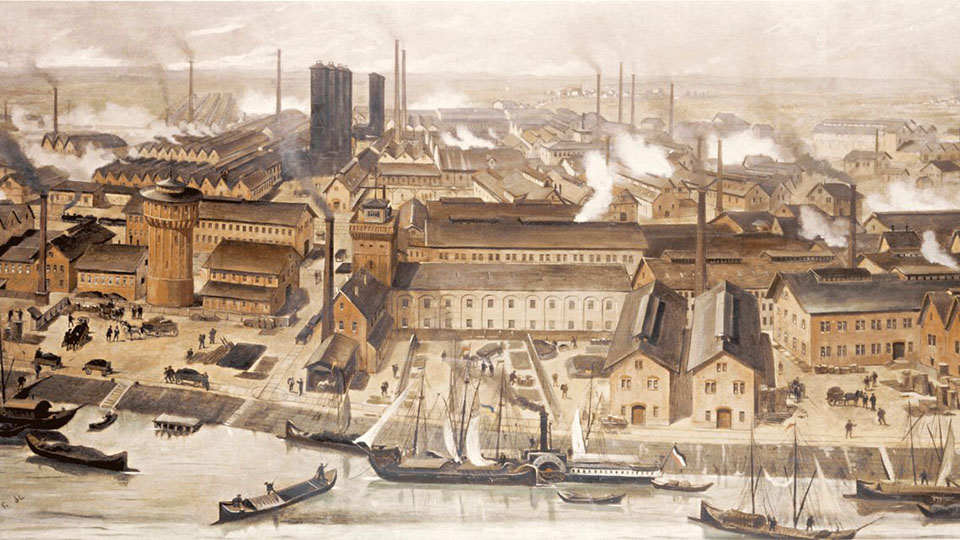
The BASF works at Ludwigshafen in 1881, painted by Robert Friedrich Stieler
By the late 1800s all of the major developments in black synthetic dyes took place in Germany. In 1891 von Hoffmann developed the bluish-black di-azo dye, amido black, now known as C. I. Acid Black 1. The di-azo dye, Azo Acid Black was developed at Hoechst in the 1890s. It is actually a mixture of different dyestuffs - a blackish-blue, a green, a violet-blue and an orange (Gardener 1968, 65). It has strong binding power, but is only moderately wash-fast (Hunger 2007, 283). Acid dyes are soluble in water and are mainly used to colour animal fibres such as wool and silk, and synthetic fibres such as nylon. They are unsuitable for cotton.
The tri-azo dye Direct Deep Black was first produced by Bayer in 1898, but was not patented (Wizinger 1973, 65). It was rediscovered in 1901 by Oscar Müller of Schöllkopf Company in Buffalo, Ohio, who called it Erie Black. Azo dyes contain the azo group –N=N- which functions as a chromophore in the dye molecule (Christie 2015, 72 and 92). Direct Deep Black is composed of three different azo dye units, each containing a different chromophore. It quickly became a commercial success. By 1924 the production of Direct Deep Black in the USA amounted to 24,000 tonnes, representing 8% of total dye production (US Tariff Commission 1924, 52). In the 1960s it was still one of the most popular azo dyes (Becker, Berger and Domschke 1973, 568).
The first black sulphur dye was synthesised by Ramond Vidal in France in 1893 (Wizinger 1973, 65). Unfortunately it did not produce a pure black and required after-treatment (Georgievics and Grandmougin 1920, 493). The first sulphur black to give a satisfactory deep black shade was Immedial Black, discovered by Kalischer in 1897. It was soon followed by the development of Sulphur Black by Priebs and Kaltwasser at AGFA in 1899 (Hunger 2007, 78). This was a polymeric dye that produced a deep incomparable shade of black on cotton. It would eventually become one of the most widely used dyes in the world - by around 1950 it accounted for 10% of US dye production (Waring and Hallas 2013, 82).
A multitude of other black dyes have since been developed and commercialised. However only a minority have stood the test of time. In the 1990s the three most commonly manufactured black dyes were C. I. Sulphur Black, C. I. Reactive Black 5 and C. I. Acid Black 194 (Zollinger 2003, 12). The only dyes produced in greater quantities were synthetic indigo and a mono-azo synthetic blue.
C. I. Sulphur Black
According to Asim Kumar Roy Choudhury, the reason that C. I. Sulphur Black 1 is one of the most widely used dyes in the world is because there is nothing comparable that can achieve such a deep attractive black shade on cotton (2006, 586). It is also reasonably inexpensive. Even so it still only produces a greenish-bluish black. Some 120,000 tons are produced annually (Sanchez 2015, 114).
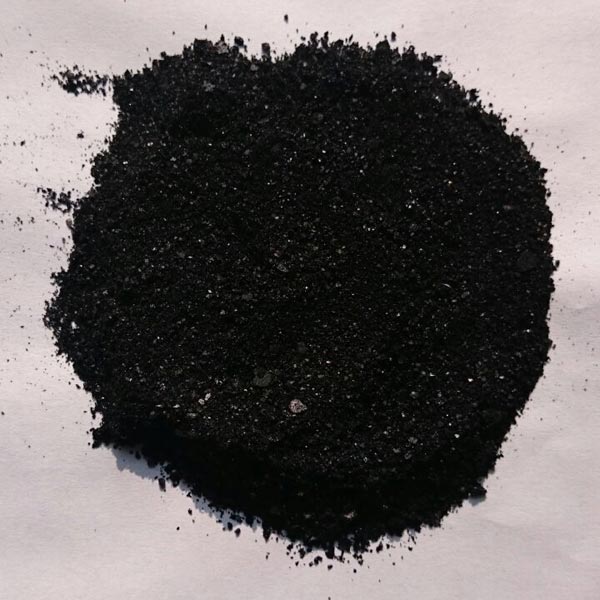
C. I. Sulphur Black in powder form
The process of dyeing Sulphur Black is somewhat similar to that required for indigo. Sulphur Black is insoluble in water and is therefore applied in its soluble form and then chemically oxidised to its insoluble form, which then hydrogen bonds with the cellulose fibre (Sanchez 2015, 114-115). This is why the dye has such good fastness.
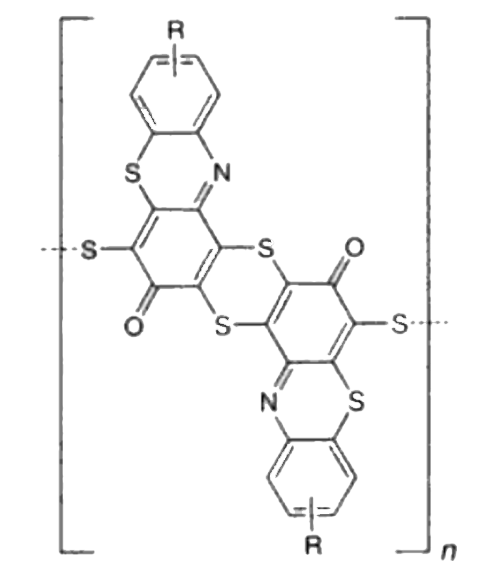
C. I. Sulphur Black 1 is a polymeric di-thiazone containing from 2 to 10 di-thiazone groups.
C. I. Reactive Black 5
Reactive dyes were developed in the 1950s and react with cellulose textile fibres, forming strong chemical covalent bonds. They are not only easy to apply, but also result in previously unattainable shades and very high levels of fastness.
C. I. Reactive Black 5 is the world’s largest selling reactive dye (TEXINCON 1997, vol. 9, 11). Introduced by Hoechst in 1957 as Remazol Black B, it is a di-azo dye containing two vinyl sulphone groups:

It is supplied in a stable storage form, which does not react with fibres. Dissolved in aqueous alkali it is transformed into its highly reactive vinyl sulphone form, which then binds directly to the ionised cellulose polymers that make up the cotton fibre.
For those with an interest in advanced chemistry the process involved is called nucleophillic addition (Koh 2011, 141). Basically, the vinyl sulphone end chains form strong C-O covalent bonds with the ionised hydroxyl groups along the cellulose polymer chain.
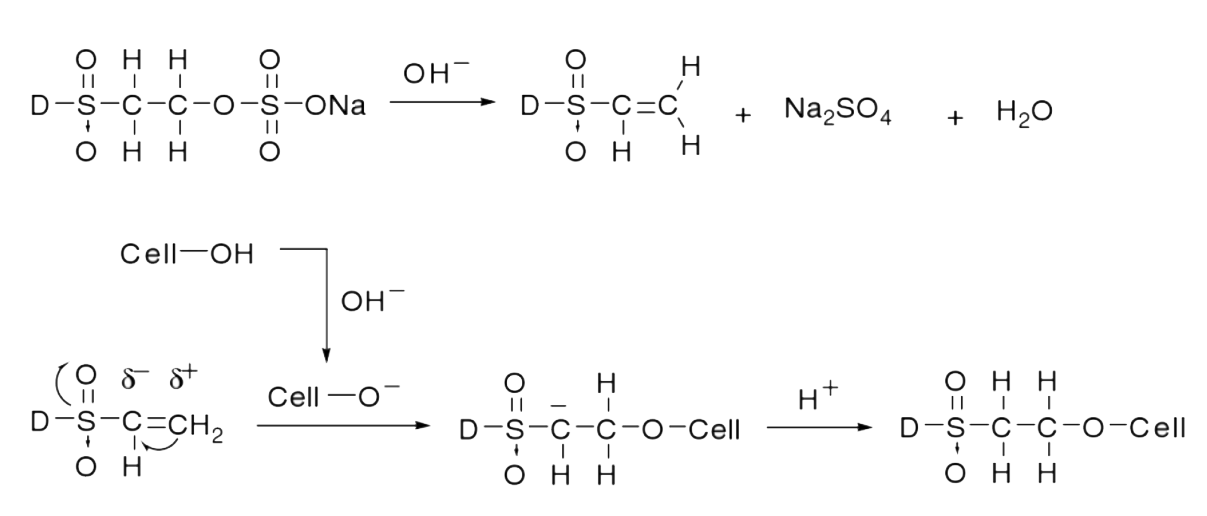
Binding mechanism of a vinyl suphone dye with cellulose
Cell represents cellulose and D represents the dye chromophore (From Koh 2011, 141)
Return to Top
The Spread of Early Synthetic Dyes
Aniline dyes began their penetration of Asian markets during the second half of the nineteenth century – not long after they had become commercialised in Europe. Thanks to established colonial trade links they quickly became available in British Burma and the Malay States, French Indo-China and the Dutch East Indies. Some regions adopted them rapidly, whilst others were more resistant to change. Broadly, commercial producers were the fastest to exploit these new dyes while more isolated domestic weavers were the slowest. Even so, apart from a few setbacks during times of war and economic downturn, the spread of chemical dyes has proved unstoppable. Today their use is almost universal, with only a few dispersed communities maintaining their traditional methods of natural dyeing. In the following review we have attempted to assist comprehension by converting all weights into metric tonnes and all values into US dollars, the latter adjusted by inflation to current 2016 prices. The source values are given in brackets.
By 1879-80 annual imports of aniline dyes into British India were increasing so much that they were causing concerns about the future of indigenous vegetable dyes (Review of the Maritime Trade of British India 1880, 34). Likewise, weavers in British Burma seem to have been relatively open to the acceptance of imported dyes – although Michael Howard may be a little early in suggesting that aniline dyes first appeared in lowland Burma in the mid-nineteenth century (Howard 2005, 27). On the other hand Punvasa Kunlabutr’s (2004, 91) suggestion that they were introduced in 1880 is probably too late. German aniline dyes were already ousting native vegetable dyes during the 1880s (Colquhoun and Hallett, 1888, 75).
The situation was summarised in an 1896 monograph written by J. D. Fraser on Burmese natural dyes and dyeing (see Scott and Hardiman 1900, pt. I, vol. 2, 377-399):
‘Unfortunately native dyes are being rapidly ousted by the common aniline dyes of European manufacture, which give a bright and gaudy colour, instead of the subdued and artistic tones obtained from native ingredients. Besides the meretricious results most of the aniline colours give, they have not the important merit of permanence, but fade rapidly when exposed to the sun.’
Aniline dyes were cheap, available in every bazaar and far easier to use than the complicated and time-consuming native processes. The use of local dyes was still practised in out-of-the-way parts, but only for domestic use. In the silk-weaving centre of Mandalay, aniline dyes had already displaced all but a handful of traditional dyestuffs - annatto, turmeric, lac and safflower.
Aniline dye imports to Burma were recorded as 19 tonnes (42,044lbs) in 1890-91 and 24 tonnes (53,350lbs) in 1895-96. By 1899-90 imports of chemical products and dyestuffs had reached just $4.15 million (£30,404) (Nisbet 1901, vol. 1, 351 and 451). In John Nisbet’s opinion, native vegetable dyes had only been displaced by ‘gaudy’ aniline dyes ‘to a certain extent’.
The situation in the remoter Shan States had already been reported by Holt Hallett who discovered that German aniline dyes were already displacing traditional vegetable dyes, the preferred colours being indigo, orange, maroon and reddish-brown (Hallett 1890, 87). This situation in the Shan States was corroborated by H. G. A. Levenson, who found that aniline dyes were being imported in considerable quantities in the late nineteenth century and were in use in all parts of the country (Scott and Hardiman 1900, part I, vol. 2, 391). Even as far east as Kengtung, tins of dyes of all colours were available at every large bazaar. Even in Muang Sing, which had become part of French Indo-China, aniline dyes were in common use in place of native dyes. Natural dyeing tended to be restricted to the hill tribes and the more remotely located Shans. It seems that in some isolated communities like the Burmese Naga, access to aniline dyes did not occur until after the 1920s (Howard 2005, 34). A similar delay appears to have occurred with the Jingpho of Upper Burma, who only later substituted their natural indigo for black commercial dyes (Howard 2005, 177).
Aniline dyes were probably introduced into China in the 1860s (Hawley 2012). Not long after they probably travelled south, down the trade routes into Lan Na (Conway 2002, 180). The first record of aniline dyes arriving in Chiang Mai from Bangkok dates to 1893 (Warrington Smyth 1898, 289). However independent Siam may have been more resistant to the use of chemical dyes than the other colonial parts of Southeast Asia. In 1907, Siam imported only $1.22 million (133,409 ticals or $49,361) of dyes from eight foreign countries (US Bureau of Foreign and Domestic Commerce 1918, 394). During the following six years the average yearly import value was just $1.2 million (130,862 ticals or $48,419). Aniline and synthetic indigo imports were mainly from Germany.
By 1898 in Laos, German aniline dyes were already being sold on the market at Luang Prabang (Lefèvre 1898, 135). By 1906, German powdered aniline dyes had already been in use for 15 years (Reinach 1906, 107). Aniline dyes were being used in many households for dyeing home-woven cloth (L’Asie Francaise 1907, vol. 8, 354). In Cambodia, sampot weavers were already obtaining ‘boulettes’ of German aniline from the pharmacies of Phnom Penh to dye their silk yarns (Valat 1913, 59).
In Malaysia natural dyes were already gradually being replaced by German and British dyes as early as 1900 (Mohamad 1996, 157). Some colonial officials looked on the increasing use of a rainbow of aniline dyes as a curse (Papers on Malay Subjects 1911, 1). By 1909 the British colonial official, Richard Winstedt, was so alarmed by the decreasing use of natural dyes in the Malay States that he advocated instant dismissal for the use of aniline dyes in every government institution (Winstedt 1909).
In the Dutch East Indies the first aniline dyes had already come into use by 1890 (Rodgers, Summerfield and Summerfield 2007, 31 and 120). They were introduced into Borneo in the late 1800s (Kreifeldt 2006, 110). Traude Gavin believes they arrived in Sarawak no earlier than 1880 (Gavin 1996, 92). They probably reached parts of the Lesser Sunda Islands not long after, especially those ports that were serviced by Dutch steamers – Pabean on Bali, Apenan and Labuan Haji on Lombok, Ende and Larantuka on Flores, Waingapu on Sumba, and Kupang and Atapupu on Timor, as well as the islands of Roti and Savu (A Manual of Netherlands India 1920, 80, 382 and 387).
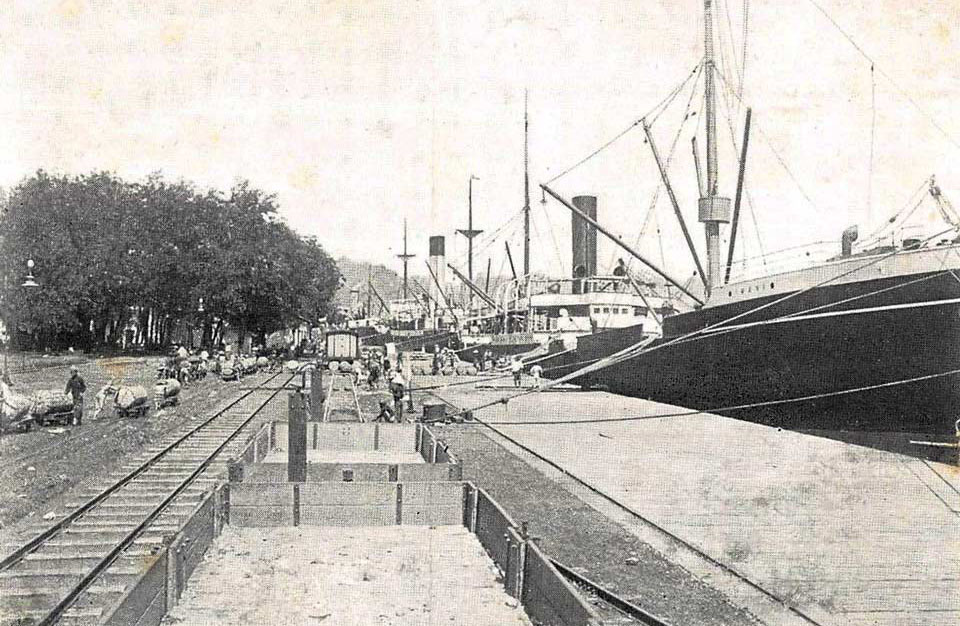
KPM (Koninklijke Paketvaart-Maatschappij) steamships unloading cargo at Cilacap Harbour, South Java, around 1899
It is likely that the batik workshops of north coast Java were the first to recognise the commercial advantages of aniline dyes (Maxwell 1990, 370). Dyes like alizarin offered a much faster and cheaper way of producing red than natural morinda. They undoubtedly appeared on Java during the late nineteenth century, but exactly when remains unclear. McCabe Elliot (2013, unnumbered) suggests they only began to be used in 1898, while several other authors claim that they began to be used around 1900 (Veldhuisen and Hiang 1993, 114; Brenner 2012, 258). Even so, we wonder if these dates are a little on the late side. As early as 1904 one Dutch writer was complaining that traditional batik-making had been corrupted with European designs and dyes (Fock 1904, 108-109).
The adoption of chemical dyes was not all plain sailing. Some batik workshops soon encountered major technical problems and reverted to using vegetable dyes (Veldhuisen and Hiang 1993, 114). Unconstrained by Javanese traditions, the Peranakan Chinese batik-makers in Pekalongan seem to have been the first to fully exploit them (Maxwell 1990, 265). One writer has suggested this was because the Chinese had a preference for brighter colours (Veldhuisen 1991, 166). Chemical dyes quickly replaced all natural dyes in Pekalongan although in the other main batik centres such as Surakarta and Yogyakarta aniline dyes were adopted selectively and used alongside the important natural brown dye, soga jawa (Brenner 2012, 258). Jasper and Pirngadie recorded how aniline dyes were being used alongside or mixed with natural dyes to produce stronger colours (1916, 45-48).
On Bali aniline dyes seem to have been quickly adopted by local endek producers. By 1908 they were already using aniline to dye their weft ikat (Jasper and Pirngadie 1912, 186 and 288). In that very same year Dutch officials at Buleleng were complaining about the loss of quality caused by the use of ‘gaudy’ aniline dyes (Hauser- Schäublin, Nabholz-Kartaschoff and Ramseyer 1991, 21). By 1916 silk kain pelangis were being entirely dyed with aniline on both Bali and Lombok (Jasper and Pirngadie 1916, 239).
Even in central Sulawesi, imported aniline dyes were readily available by the end of the nineteenth century, and were used for decorating barkcloth (Adriani and Kruyt 1901, 158).
Trade statistics just before the First World War give an indication of the flow of dyes into Asia in the early twentieth century. In 1913 China imported $96 million ($4 million) of aniline dyes and $167 million ($7 million) of synthetic indigo, mainly from Germany and Belgium (The National Review China 1915, 406). In French Indo-China imports in 1913/14 were a mere $0.6 million (14-16,000 Tls - Tientsin or Chinese dollars) (Pamphlets on Forestry in Indo-China 1918, 613).
Some 333 tonnes of aniline dyes were imported into the Netherlands East Indies in 1913, virtually all through Java (see table below). Although the batik industry was probably the largest consumer, aniline dyes were also appearing in the outer islands. In the Batak region of Sumatra, European missionaries were encouraging local weavers to adopt aniline dyes (Joustra 1914, cited by Philips and Steiner 1999, 163). A few years later Herman Visser complained about the bright aniline colours and imported yarns that were now used to weave Toba Batak textiles (Visser 1918/19, 22).

Brilliantly colored labels played an important role in the marketing of the dyes. Bayer dye packaging for the Chinese market in about 1900 above, and after 1912 below

Shortly after the outbreak of the First World War, Germany instituted a ban on the export of synthetic dyes to Britain and its allies. The British responded with a naval blockade of Germany. The impact was immediately felt in Java, where prices rocketed – the price of a barrel of alizarin jumped from 63 to 2,000 guilders (Van Dijk 2007, 365). Batik producers attempted to switch back to natural dyes. After the Netherlands Indies agreed to ban the re-export of synthetic dyes, Berlin allowed dyes to be exported to Java in line with 1913 levels of demand. In 1916 the British Consul-General in Batavia became dissatisfied with the way that Dutch firms on Java were distributing (re-exporting?) their artificial dyes, and shipments were temporarily confiscated. The British Navy forced several Dutch steamers to discharge their cargoes of aniline dyes. One was carrying 1,400 cases (The Argus, Melbourne, 6 June 1916).
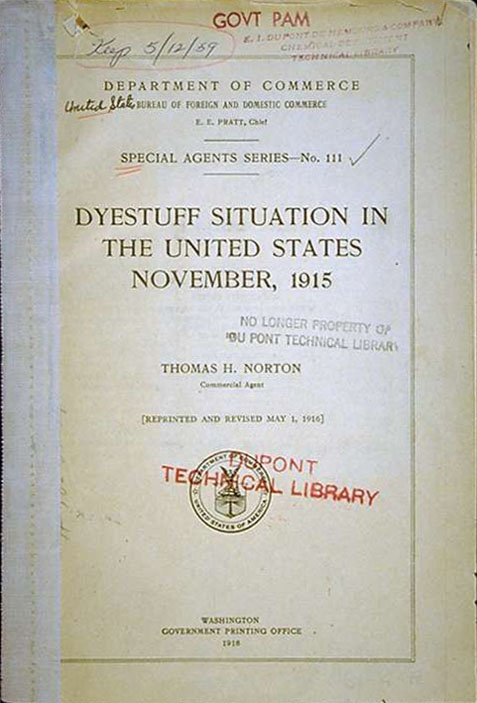
Report on the US 1915 'dye famine'
(Image courtsey of the Hagley Museum & Library)
After the war, imports of aniline dyes began to recover. The German dye industry emerged from the war intact and although it faced tariff barriers and stronger domestic competition in North America and Europe, it faced no similar obstacles in Asia. Meanwhile the US chemical industry had responded to the blockade on German exports by moving into the production of synthetic dyes. By 1920 over one hundred US plants were manufacturing almost $100 million of dyes (Mock 2002, 81). They too were beginning to export to Asia:
US Exports of Aniline Dyes in 1920 |
||
Country |
$000s (1920 Values) |
$000s (2016 Values) |
China |
5,074 |
63,425 |
British India |
2,774 |
34,675 |
Thailand |
10 |
125 |
French Indo-China |
93 |
1,163 |
Philippines |
91 |
1,138 |
Dutch East Indies |
23 (137 in 1919) |
288 (1,713 in 1919) |
(Source: US Bureau of Statistics 1921)
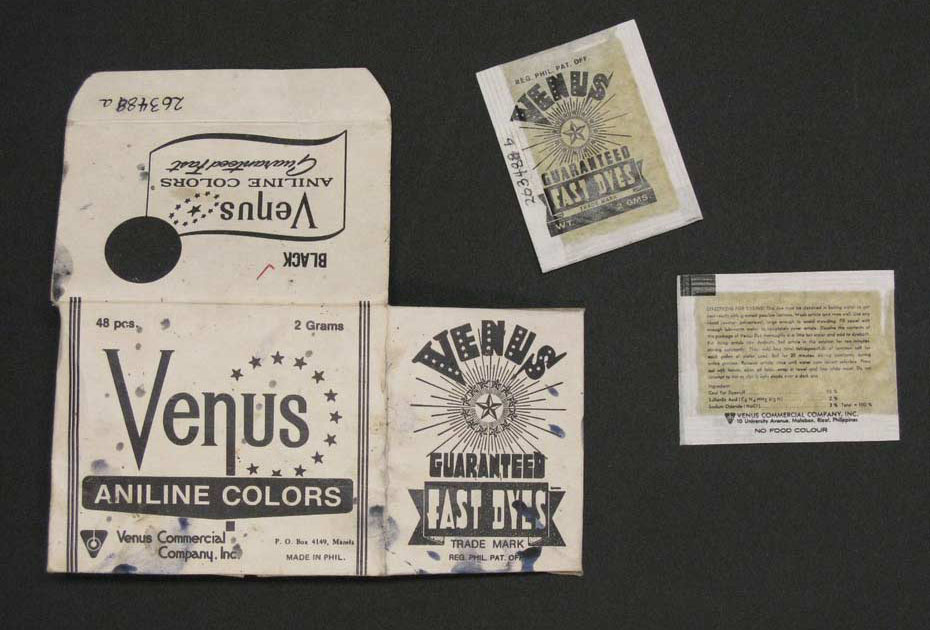
A black aniline dye from Philadelphia sold by Venus Commercial, Manila, Philippines
(Image courtesy of Yale Peabody Museum, New Haven)
In order to re-establish its former dominant position, the German dye industry decided to consolidate. In 1925 AGFA, BASF, Bayer, and Hoechst - along with six smaller manufacturers - merged to form Interessen-Gemeinschaft Farbenindustrie A.G. ('Dye Industry Syndicate'), headquartered in Frankfurt. In important territories like China, local sales agents were replaced by direct sales offices. By 1933, 50% of I. G. Farben’s dye exports were destined for Asia (Tammen 1978, 367).
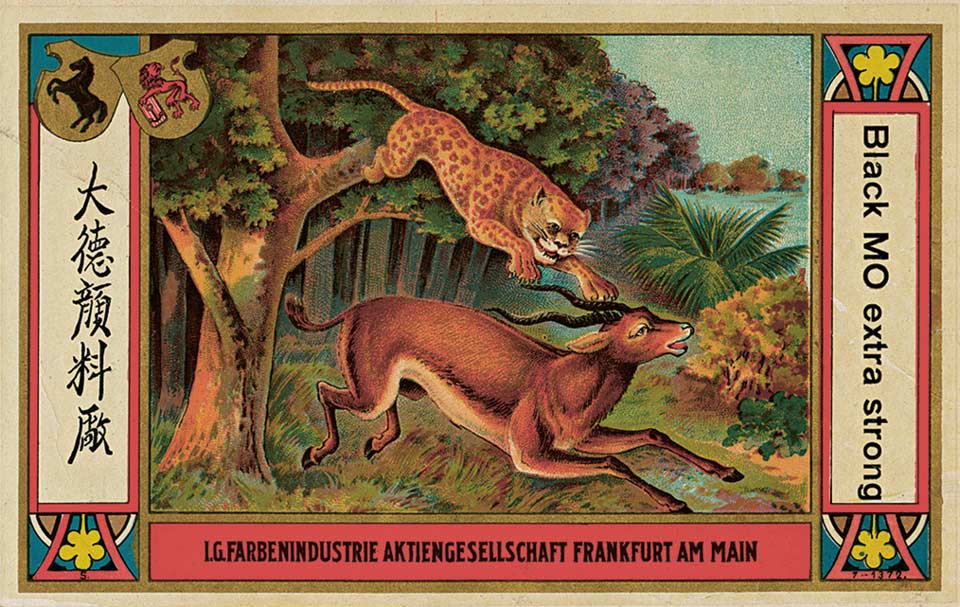
Chinese label for the I. G. Farben diazo dye, Black MO
In Siam it was reported that native vegetable dyes were being displaced by imported aniline dyestuffs, although the important Bangkok industry for dyeing black (with ebony) remained unaffected (Drug and Chemical Markets 1917, vol. 4, 14). Yet in 1923 Siam imported only 212 tonnes of foreign dyes valued at £46,000 – 25% from China, 22% from Denmark and 13% from Germany, the Danish imports probably being of German origin (Chemical Trade Journal and Chemical Engineer 1924, vol. 74, 350). By 1926 there was even a German agent in Chiang Mai authorised to sell imported synthetic dyes (Pasqual cited by Conway 2002, 233). By 1941 Thomson complained that cheap, gaudy and multi-coloured aniline dyes had penetrated everywhere and that demand for foreign dyestuffs was still increasing (1941, 443).
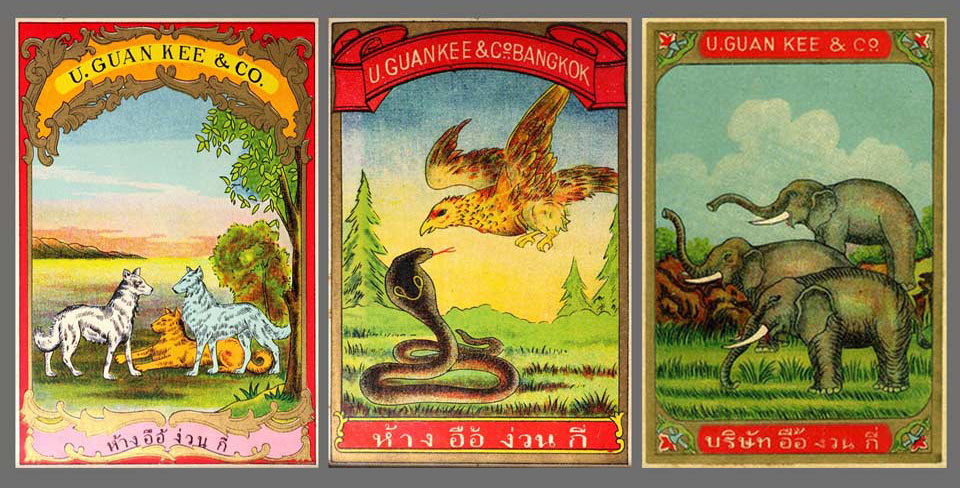
Branded labels for German dyes sold by U. Guan Kee & Co., Bangkok
In French Indo-China, Germany aniline dyes had been replaced during the war by dyes from Britain (Textile Colorist 1918, vol 40, 119). In 1918 the principle demand in Saigon was for aniline dyes for colouring cotton.
Demand was growing strongly in Singapore and the Malay States, the best-selling colours being violet, dark green, magenta and scarlet - although there was also demand for pink, blue, light green, orange and yellow (Far Eastern Review 1919, vol. 15, 244). By the 1920s indigenous knowledge about the preparation of natural dyes was being lost in many of the Malay States although some - such as Kelantan and especially Pahang and Pekan - remained firmly resistant to change (Mohamad 1996, 158-159). In the latter region the district officer refused to sell any sarongs that were not vegetable-dyed. By the 1930s however, even tiny Pekan had succumbed to the use of chemical dyes.
In the Dutch East Indies German dye manufacturers had been held in high esteem and many of their exports were channelled through Holland. Imports dropped precipitously during the war, especially at the end in 1918. They only began to fully recover in 1920.

(Source: Markets for Chemicals in the Netherlands East Indies and British Malaya, US Bureau of Foreign and Domestic Commerce 1922, 4-5)
It was not long before German suppliers regained their pre-war position (Report on Economic and Commercial Conditions in the Netherlands East Indies 1922, 38). By 1923 the Dutch East Indies was importing 246 tonnes (245,673kg) of aniline dyes and 426 tonnes of synthetic indigo (Report on Economic and Commercial Conditions in the Netherlands East Indies 1938, 45). Dutch East Indies imports of dyes in 1925 were valued at 4,832,978 florins, of which alizarin dyes totalled 792,568 florins, aniline dyes 2,748,125 florins and synthetic indigo 1,392,285 florins (Chemical Trade Journal 1928, vol. 81, 275).
On Java the supply of German aniline dyes soon came under the control of influential local Chinese merchants (Abushouk and Ibrahim 2009, 147; Larson 1987, 36). Thanks to these imported dyes, by the early 1920s the Chinese had gained a dominant role in the batik-dyeing business (Dobbin 1989, 116). When the former ethnographer to the Dutch East Indies government, Tassilo Adam, surveyed the Javanese batik industry in 1934 he found that in some parts the traditional batik-making process had been completely replaced by aniline dyeing (Adam 1934, 14).
Imports of aniline dyes into Java reached 1,064 tons in 1931, but then stabilized due to a prolonged depression in the Javanese batik trade:
Imports in tons |
1931 |
1932 |
Aniline dyes |
1,064 |
847 |
Alizarin |
225 |
194 |
Synthetic indigo |
561 |
516 |
(Economic Conditions in the Netherlands East Indies 1927?, 64)
By 1937 imports of the first two categories combined had climbed back to 1,300 tons, roughly in line with 1931 imports (Report on Economic and Commercial Conditions in the Netherlands East Indies 1938, 31).
It is hard to find historical references indicating the speed of uptake of chemical dyes in those parts of Indonesia beyond Java and Bali. In his review of ikat-making in the Dutch East Indies, Charles Iklé made the general comment that ‘the beautiful old vegetable dye process now exists in a few localities’ (Iklé 1931, 10). A decade later Raymond Kennedy likewise observed that in the East Indies the ‘locally made coloring materials were disappearing since the importation of aniline dyes’ (Kennedy 1943, 39).
Timor is one of the few outer regions of Indonesia where synthetic dyes appear to have taken an early foothold (Kahlenberg 1979, 38). One report suggested that the important colonial trading port of Kupang resulted in chemical dyes being introduced to Timor as early as the 1870s (Hali 1983, vol. 6, 205). No supporting evidence was given. These new dyes quickly came under the control of Kupang’s enterprising Chinese merchants (Art and Asia Pacific Quarterly 1998, 45). It is possible that the trade in aniline dyes was modest. Even in the 1990s there was only one supplier in Kupang and availability was sporadic (Yeager and Jacobson 2002, 63). The import of chemically dyed yarns may have been more significant, given the propensity of Timorese weavers to decorate their cloths with brightly coloured warp stripes.

Bottom half of a mid-twentieth century tais feto from Biboki, Timor Tenghah Utara Regency, West Timor. The plain black is synthetically dyed, but the ikat has been dyed with indigo
In East Sumba the adoption of aniline dyes was fuelled by the foreign demand for decorative hinggis in the early decades of the twentieth century. They soon became an article of trade for enterprising local Arab and Endenese merchants. By 1920 the artist Nieuwenkamp was complaining that imported aniline dyes were being used to speed up their production (Nieuwenkamp 1920, 374). However the adoption of aniline dyes at that time must have been a fairly recent development (Wielenga 1925, 14). There is one report that small cans of German dyes were being sold in Waingapu prior to the Second World War (Adams 1969, 186). In Laboya, West Sumba, Geirnaert-Martin noted that the import of synthetic dyes had only increased since the late 1950s (Geirnaert-Martin 1992, 111).

Black chemical dye on sale at the market for weavers and dyers, Maumere, Sikka Regency

Chemical black dyes are used extensively across Sikka Regency today
Not every region was swamped by synthetic dyes. Despite their early use on Bali, synthetic dyes were only first utilised on remote Nusa Penida in the 1930s, where they were used for the monochrome border stripes (Hauser-Schäublin 1997, 99). It was not until the 1950s that they completely superseded natural dyes on that island. In Sarawak the pacification drive by Charles Brooke meant that in many areas pre-dyed commercial yarns became available to the Iban at the end of the nineteenth century (Heppell 1994, 131). The Iban, especially in the southern Saribas region, began to incorporate these yarns into the borders of their pua cloths - but no earlier than 1880 (Gavin 1996, 17 and 92). However thanks to firm resistance by the older women, the adoption of aniline dyes did not occur until after 1949. By 1990 even dyers in remote longhouses in Kapit district were using tins of commercial dyes to dye their pua cloths red and black (Berma 1996, 265). In Jambi, Sumatra, synthetic dyes were only introduced in the late 1970s (Kerlogue 1997, 141).
Today there remain just a small number of enclaves scattered across Southeast Asia and the Indonesian archipelago where natural dyes continue to be valued and preserved. However natural dyeing is laborious and, faced with competition from synthetically dyed alternatives, the financial rewards are not high. While many mothers still pass on their knowledge to their daughters, many youngsters show no inclination to maintain the traditions of the past. In our view the outlook for the future of natural dyeing in fast-developing Asia remains precarious.
Return to Top
Bibliography
Böhmer, Harold, 2002. Koekboya: Natural Dyes and Textiles, REMHÖB-Verlag, Ganderkesee.
Burkill, Isaac Henry, 1966. A Dictionary of the Economic Products of the Malay Peninsula, vols. I and II, Governments of Malaysia and Singapore.
Cardon, Dominique, 2007. Natural Dyes: Sources, Tradition, Technology and Science, Archetype Publications, London.
Chairat, M., Bremner, J. B. and Chantrapromma, K., 2007. Dyeing Cotton and Silk yarn with the Extracted Dye from the Fruit Hulls of Mangosteen, Garcinia mangostana Linn, Fibres and Polymers, vol. 8, no. 6, pp. 613-619.
Clark, Matthew, 2011. Handbook of Textile and Industrial Dyeing: Principles, Processes and Types of Dyes, Cambridge.
Cunningham, Anthony B.; Maduarta, I. Made; Howe, Jean; Ingram, W.; and Jansen, Steven, 2011. 'Hanging by a Thread: Natural Metallic Mordant Processes in Traditional Indonesian Textiles', Economic Botany, vol. XX, issue X, pp. 1–19.
Hamilton, Roy W., 1994. 'Textile Technology', in Gift of the Cotton Maiden: textiles of Flores and the Solor Islands, Hamilton, Roy W., (ed.), pp. 58–77, Los Angeles.
Janick, Jules; and Pauli, Robert E., 2008. The Encyclopedia of Fruit and Nuts, CABI.
Jansen, P. C. M., and Cardon, D., 2005. Dyes and Tannins, PROTA Foundation, Wageningen.
Jasper, J. E., and Pirngadie, Mas, 1912. De Inlandsche Kunstnijverheid in Nederlandsch Indië, Deel II, De Weefkunst, Mouton, The Hague.
Kajitani, Nobuko, 1980. 'Traditional Dyes in Indonesia', in Indonesian Textiles: Irene Emery Roundtable on Museum Textiles 1979 Proceedings, Textile Museum, Washington, D.C.
Lemmens, R.H.M.J., and Wulijarni-Soetjipto, N., 1991. Dye and Tannin Producing Plants, Prosea, Bogor.
Liles, J. N., 1990. The Art and Craft of Natural Dyeing: Traditional Recipes for Modern Use, University of Tennessee Press, Knoxville.
Nooy-Palm, Hetty, and Schefold, Reimar, 1986. Colour and anti-colour in the Death Ritual of the Toraja, Archipel, vol. 32, no. 1, pp. 39-49.
O'Neill, Charles, 1862. A Dictionary Of Dyeing And Calico Printing: Containing A Brief Account Of All The Substances And Processes In Use In The Arts Of Dyeing And Printing Textile Fabrics, London.
Subagiyo, Puji Yosep, 2007. Indonesian Natural Dyeing Recipes, Jakarta.
Tab, Nilanidhi, and Rabieb, Prachankadee, 1963. Active principles of Diospyros mollis, Proceedings of the Ninth Pacific Science Congress, vol. 5, pp. 52-54, Bangkok.
Vankar, Padma S.; Shanker, Rakhi; and Wijayapala, Samudrika, 2009. Dyeing Cotton, Silk and wool yarn with Extract of Garcinia Mangostana Pericarp, Journal of Textile and Apparel, Technology and Management, vol. 6, issue 1, pp. 1-10.
Zollinger, Heinrich, 2003. Color Chemistry: Syntheses, Properties, and Applications of Organic Dyes and Pigments, Zürich.
Publication
This webpage was first published on 24th April 2016.